Oman – a hidden gem on the edge of the Arabian Peninsula – offers everything a traveler’s heart desires: historic cities, breathtaking desert landscapes, exotic markets and beautiful beaches. In our travel report, we take you on an unforgettable journey through the sultanate, which inspires with its mix of tradition and modernity. From a charming city trip to the capital Muscat, to exciting adventures in nature and relaxing days on the Omani beaches – Oman is the perfect destination for adventurers and relaxation seekers alike. Join us on a journey of discovery that ranges from cultural highlights to idyllic coastlines. Find out everything you need to know for your own Oman vacation (even during Ramadan – the month of fasting for Muslims).
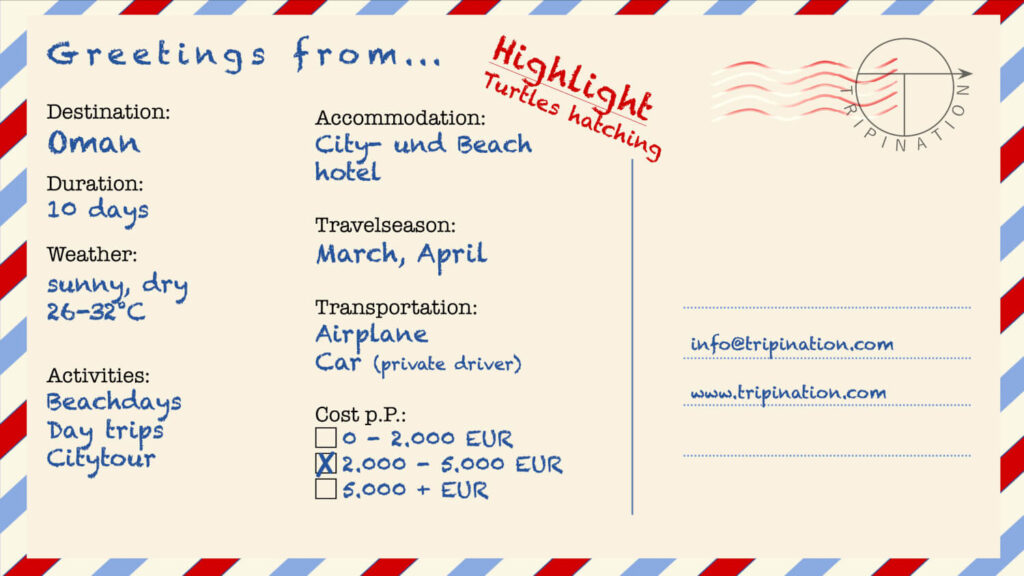
Oman – First exploration with Wadi Shab and Bimmah Sinkhole
Our journey was extremely relaxed: A direct flight of around six hours took us from Frankfurt to Muscat, the fascinating capital of the Sultanate of Oman. At the airport, we took the opportunity to change Euros into Omani Rial (the exchange rate was around 2.40 EUR to 1.00 OMR). For travelers with a need, a stop at the duty-free store is also a good idea to buy spirits – a somewhat bizarre experience, as the alcohol is literally pressed into your hand here. The airport was almost empty as most of the passengers were traveling on to other destinations, which made baggage collection probably the most relaxed ever.
For our first three days in Oman, we chose the Sheraton Oman in Muscat as our accommodation. This hotel was the ideal starting point for our city trip through Muscat. Although the ambience radiated a certain business hotel atmosphere, this in no way diminished our positive impression. On the evening of our arrival, a delicious “Ramadan Special” dinner awaited us, providing the perfect start to our travel adventure.
Oman: A pool visit with a difference
We booked our first of a total of three tours in Oman via GetYourGuide with the title “From Muscat: Wadi Shab & Bimmah Sinkhole full-day tour”*. We were picked up directly at the hotel at 8 a.m. on the dot and set off on a 10-hour day trip with a small, relaxed and pleasant group. This tour is not only recommended, but almost a must for every visitor to Oman.
To ensure that you are well prepared, you should definitely pack beach shoes, headgear, sunscreen and a waterproof cell phone case. For optimum protection, ideally add mosquito spray to your kit – that way you’ll be perfectly equipped for your adventures in Oman. Alternatively, you can also hire a car* and explore Oman on your own.
Oman for the adventurous: from the desert to the mountains
After a relaxed two-hour bus ride, we reached the breathtaking Wadi Shab, one of the highlights of Oman. But what exactly is a wadi? The term originates from the desert regions of North Africa, the Middle East and the Arabian Peninsula and describes a dried-up riverbed that only carries water during heavy rainfall or seasonally. Wadis such as the Wadi Shab or the famous Wadi Bani Khalid are not only fascinating landscapes, but also true natural oases with crystal-clear pools, lush greenery and impressive rock formations, making them some of the most popular travel destinations in Oman.
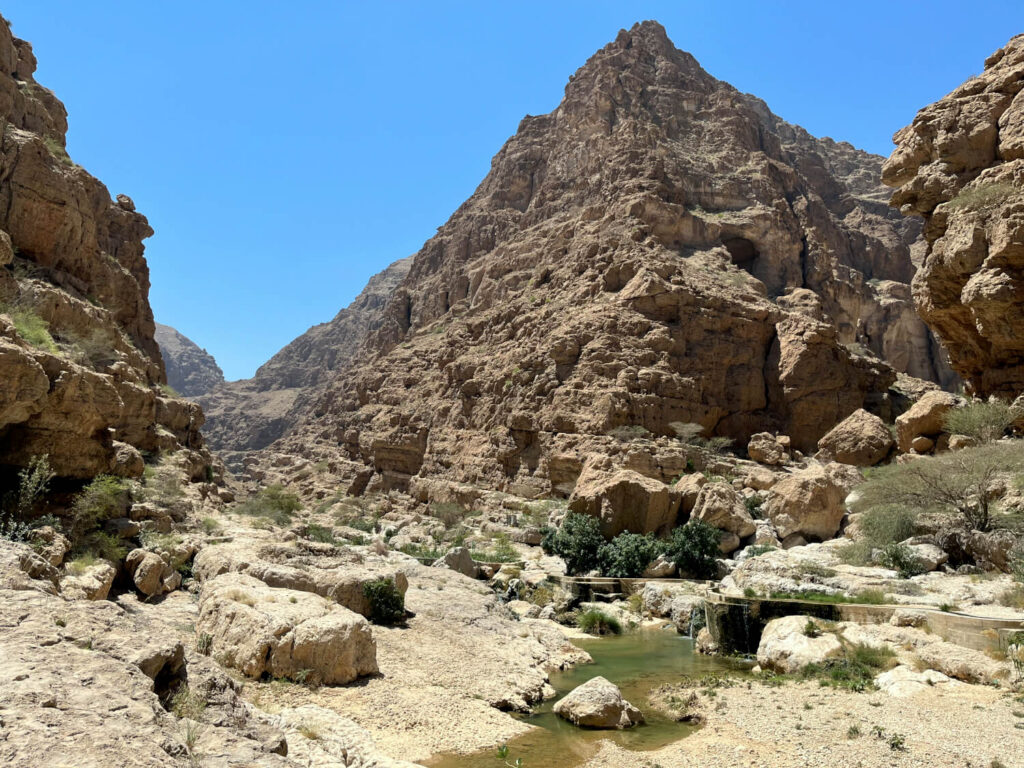
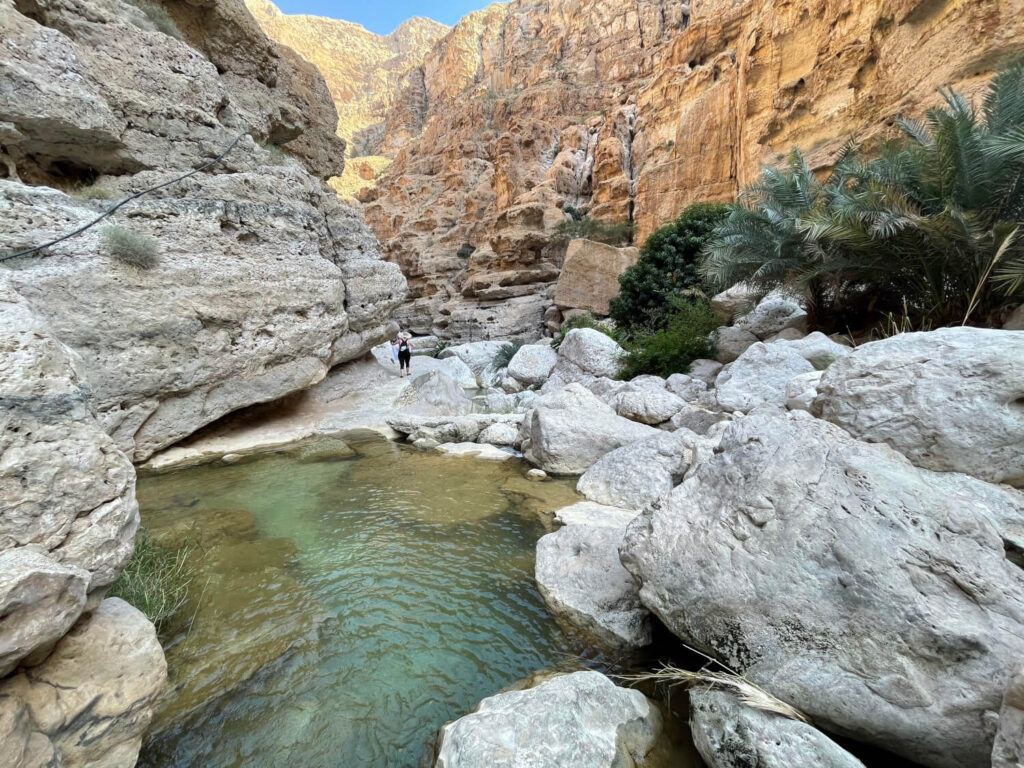
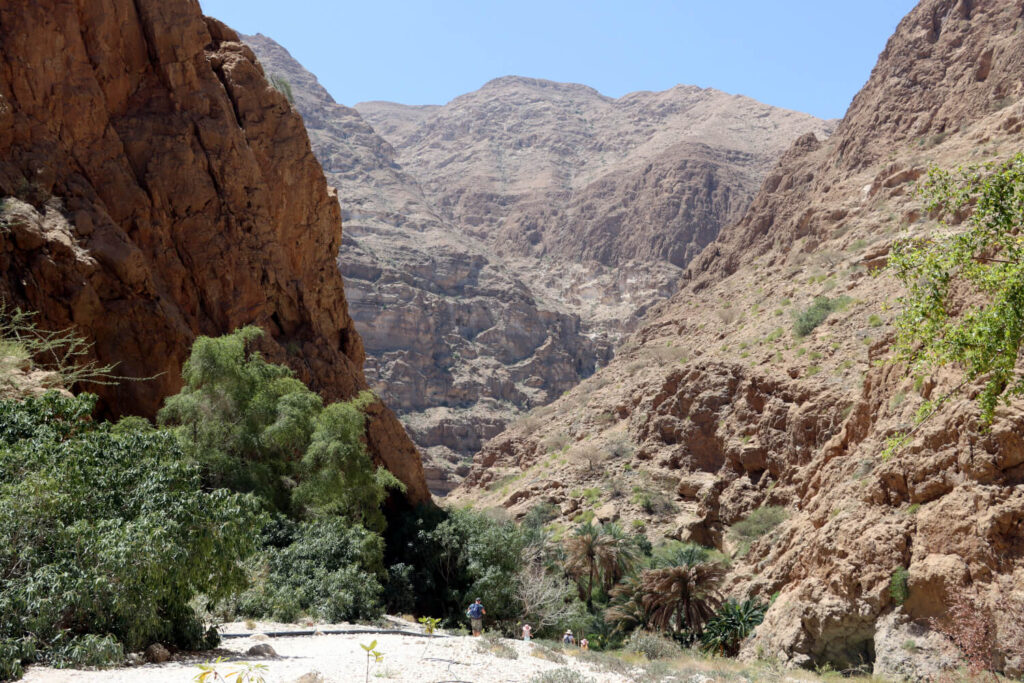
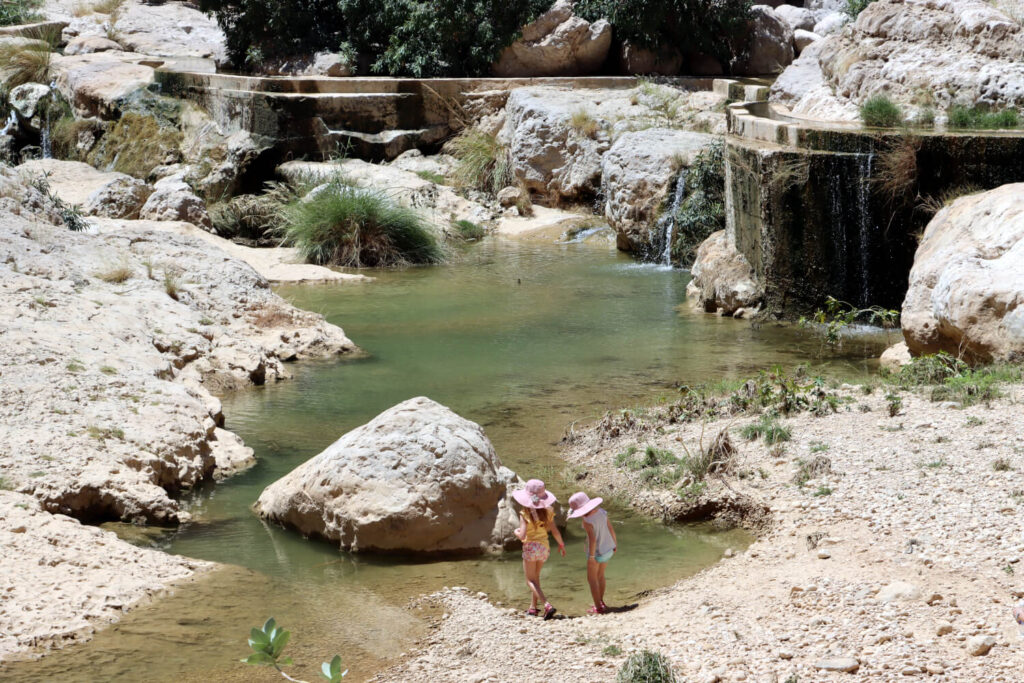
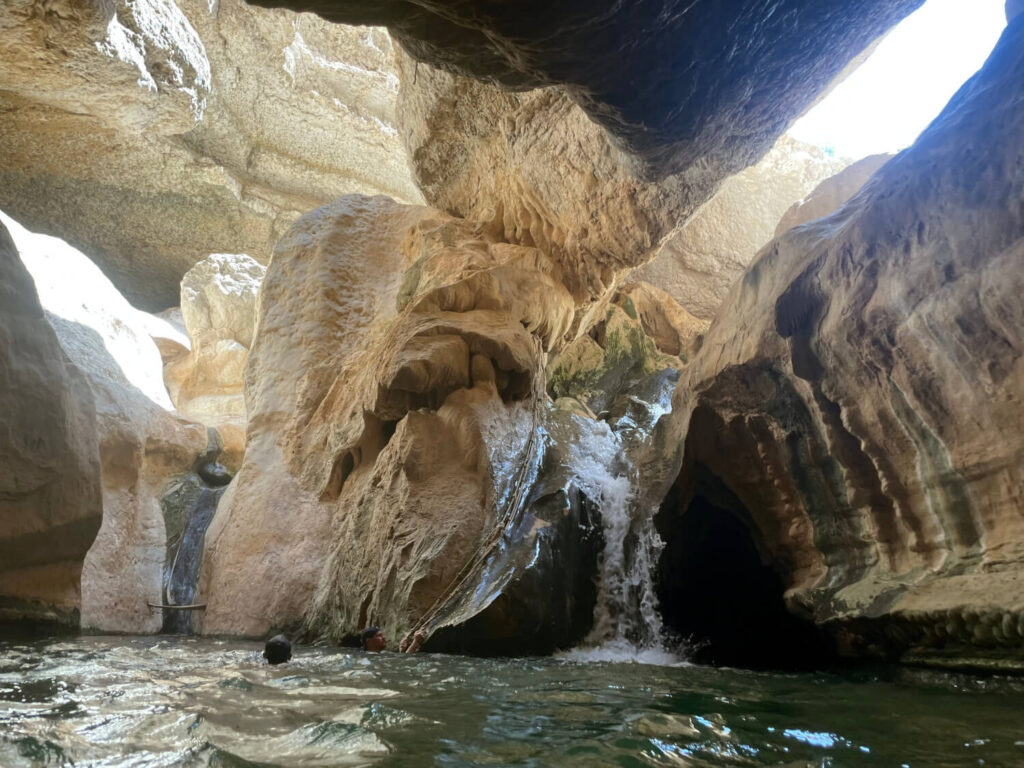
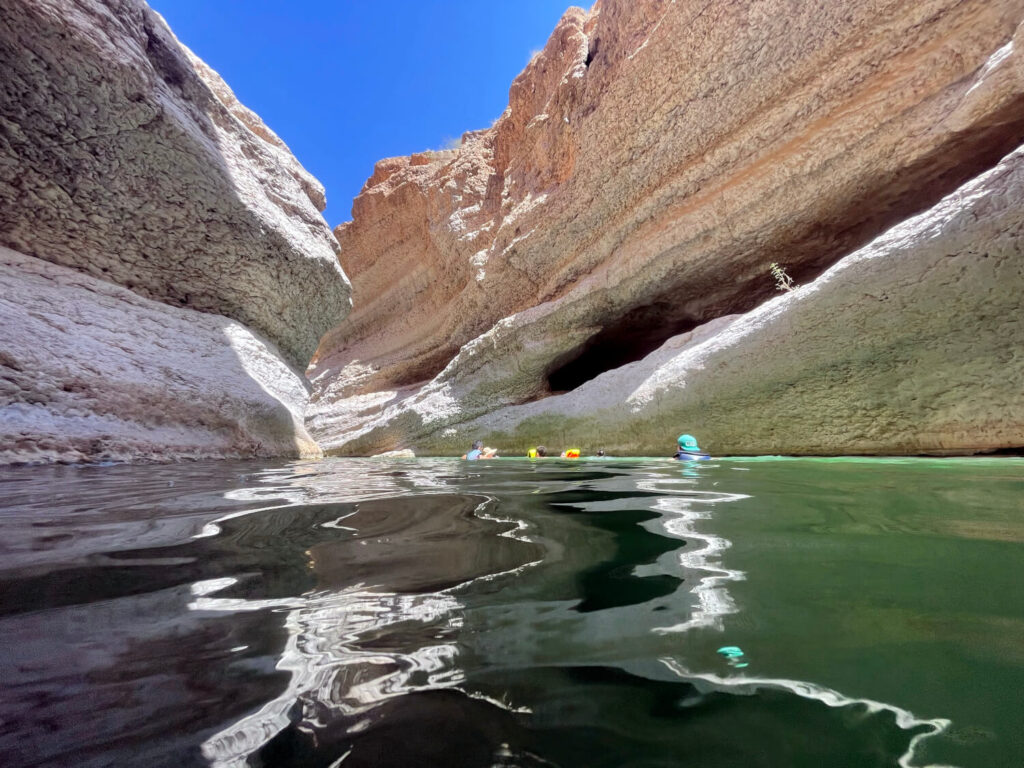
Once we arrived at Wadi Shab, we were able to rent life jackets for the equivalent of EUR 2.40 – a wise decision that provides the necessary safety for both swimmers and non-swimmers. From there, we boarded a small motorboat that took us to the other side of the river in just 30 seconds. As part of our booked tour, the crossing was already included.
Oman: Where the desert lives and the coast enchants
Next came a 40-minute hike through the spectacular nature of the wadi. The route was quite demanding, with uneven terrain, narrow slopes and sometimes slippery passages. But every effort was rewarded with fantastic views. Shortly before the pools, we took a short break to put down our things and prepare for the next highlight: the jump into the crystal-clear water.
The pools of Wadi Shab are a dream – sometimes shallow enough to walk through, sometimes so deep that you have to swim to get any further. Thanks to the borrowed life jackets, this was also possible for non-swimmers. The feeling of simply drifting along and enjoying the incomparable tranquillity of nature was indescribable. Ramadan in particular, which meant fewer visitors, gave us a unique experience in peaceful solitude.
Experience Oman: Magical desert landscapes and azure blue beaches
The destination of this exploration tour was a hidden cave with a waterfall that can be reached through a narrow crevice in the rock. This magical setting, created by nature, was the absolute highlight of our Wadi Shab expedition. After an extensive exploration and plenty of time to splash around and relax, we made our way back.
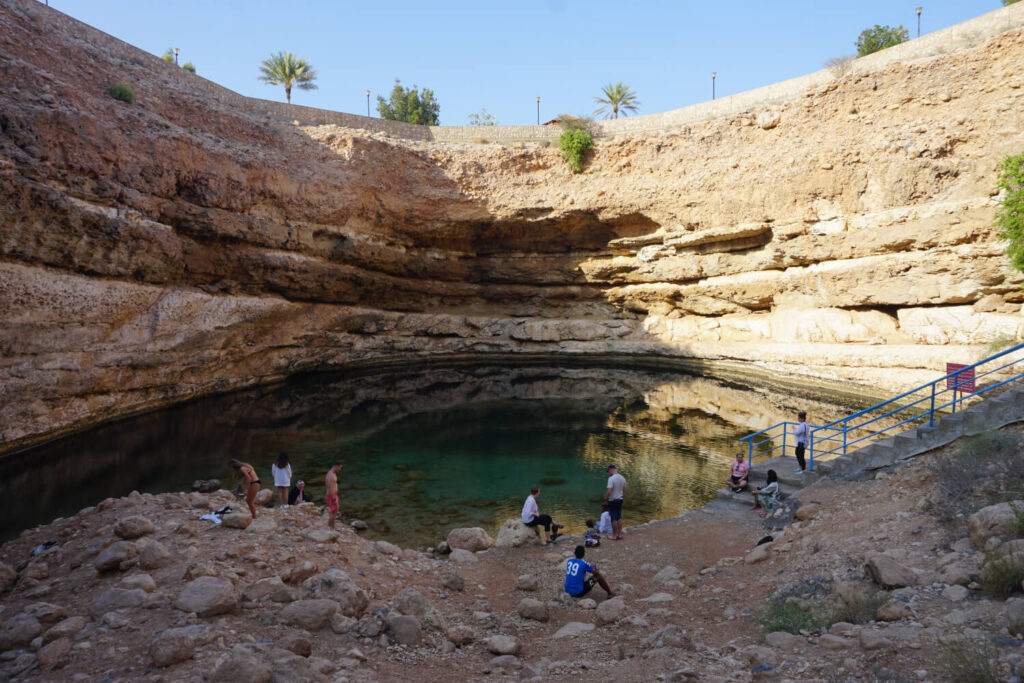
The crowning glory of the day was a visit to the Bimmah Sinkhole – one of the most fascinating geological formations in Oman. This natural karst hole, located about 120 kilometers southeast of Muscat, impresses with its turquoise blue water, which consists of a mixture of fresh and sea water. With a diameter of around 50 meters and a depth of around 20 meters, it offers an extraordinary backdrop that is not only a paradise for swimmers, but also a delight for the senses. The local name “Hawiyyat Najm”, which means “fall of the stars”, refers to the legend that the hole was created by the impact of a meteor.
After this unforgettable excursion, which impressively demonstrated the wild beauty and diversity of Oman, we returned with new impressions and deepest satisfaction – and a big piece of Oman in our hearts.
The Grand Canyon of Oman
We booked the second tour via Viator with the title “Full Day Private Tour to Nizwa and Jebel Shams from Muscat”. Our tour started promptly at 8:30 a.m. and took around 9.5 hours in total – around 3 hours of which was pure driving time. As there were no refreshments available en route, it is advisable to take enough food and drink with you. This is particularly important during Ramadan, as restaurants and cafés remain closed.
The drive provided a pleasant opportunity to take in the impressive scenery and make good use of the journey time. Our driver, who refrained from eating and drinking all day due to fasting, remained friendly at all times, but looked visibly exhausted by the end of the tour. His restraint in conversation was also explained by his conscious attempt to conserve his strength for the long day. His dedication and professionalism despite these challenges left us with great respect.
The Nizwa Souk: A market full of secrets
The highlights of this tour include the Nizwa Souk, the Nizwa Fortress, Al Hamra, Misfat al Abreyeen and the majestic Jebel Shams.
Our first stop was the Nizwa Souk, one of the most famous and oldest markets in Oman. Located in the historic city of Nizwa, often referred to as the “Pearl of Islam”, the market offers an authentic and vibrant experience of Omani culture and tradition. Located in close proximity to the imposing Nizwa Fortress, the souk invites you to immerse yourself in the history and everyday life of the region.
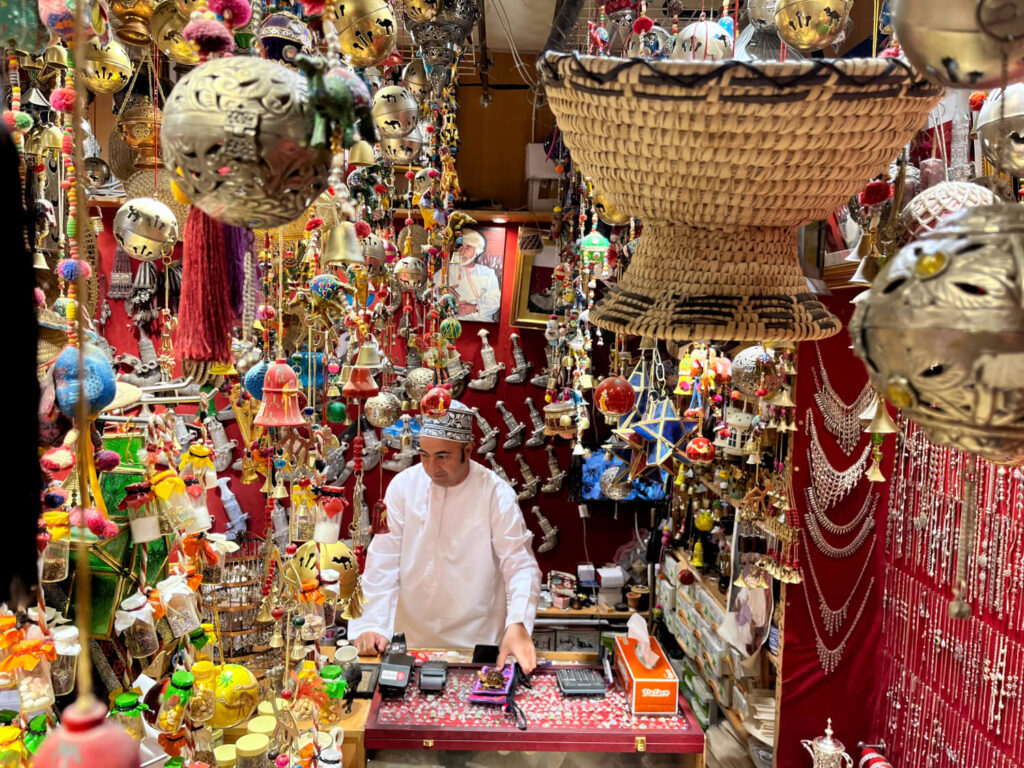
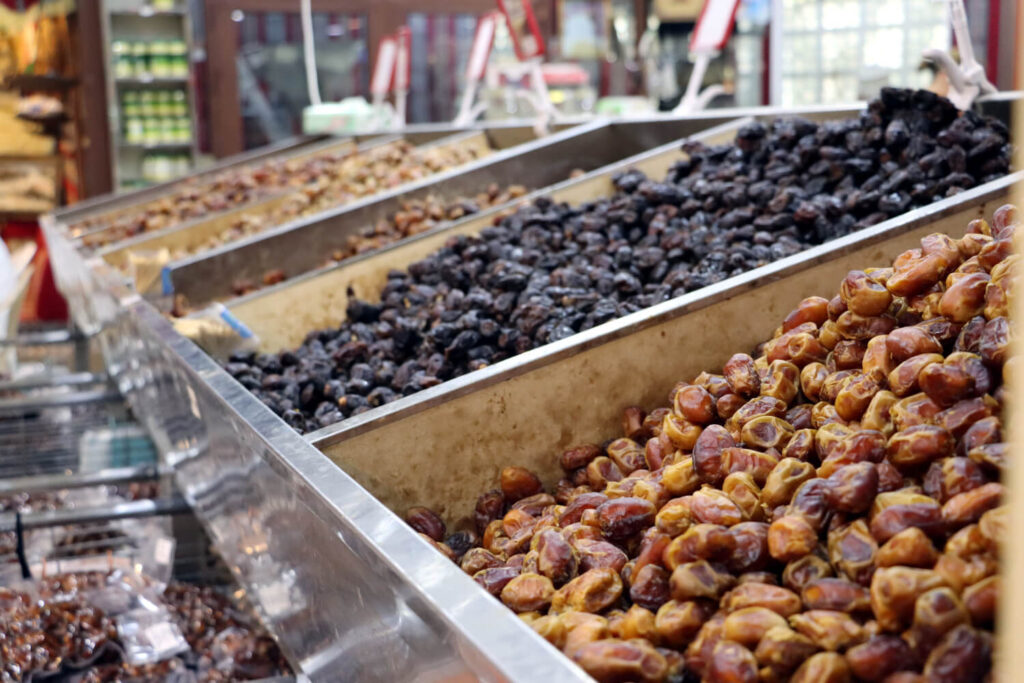
We arrived at the market on a Friday morning, shortly after 10 am. The atmosphere was calm, friendly and pleasantly unobtrusive – a rare luxury, as the market is primarily aimed at the local population and is not (yet) overrun by tourists. Here you can find a wide selection of local products such as fresh dates, regional honey, aromatic spices and artfully crafted jewelry. The animal market is particularly fascinating, providing a deep insight into the traditional trading habits of Oman.
On the trail of history: the Nizwa Fortress
The impressive Nizwa Fortress, an architectural masterpiece from the 17th century, rises right next to the Nizwa Souk. After extensive restoration work, the fortress now shines in new glory and houses a fascinating museum that provides insights into the history and culture of Oman.
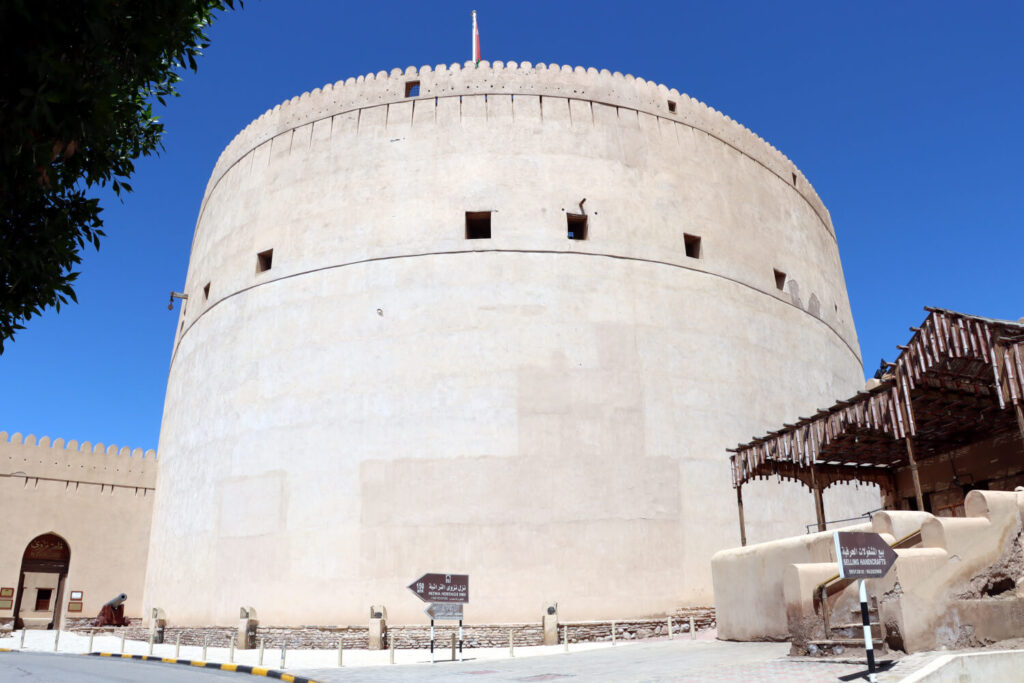
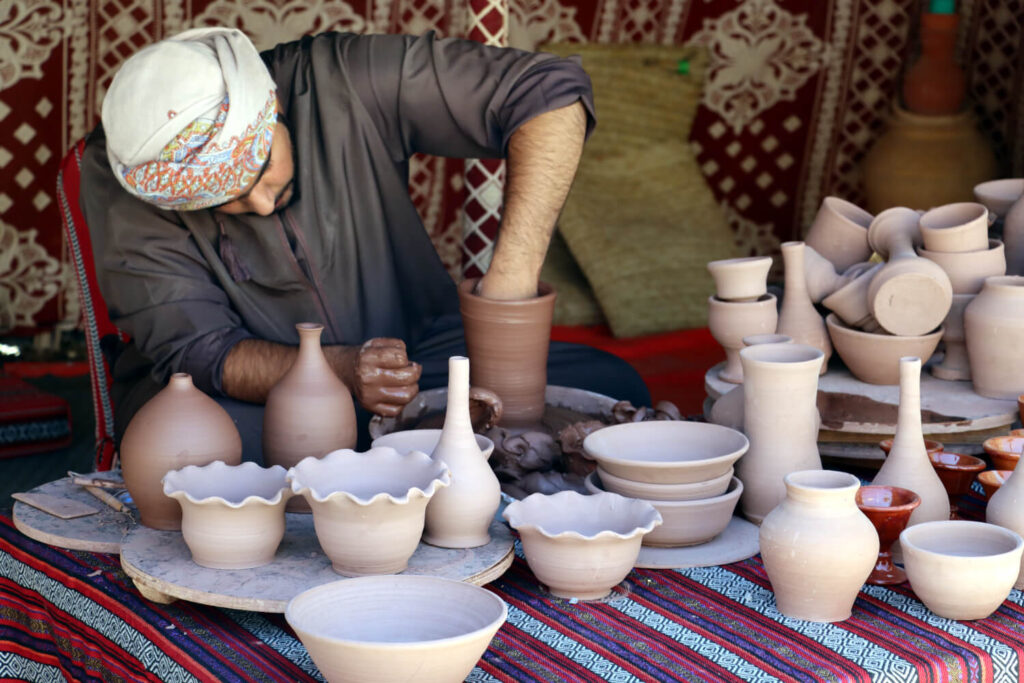
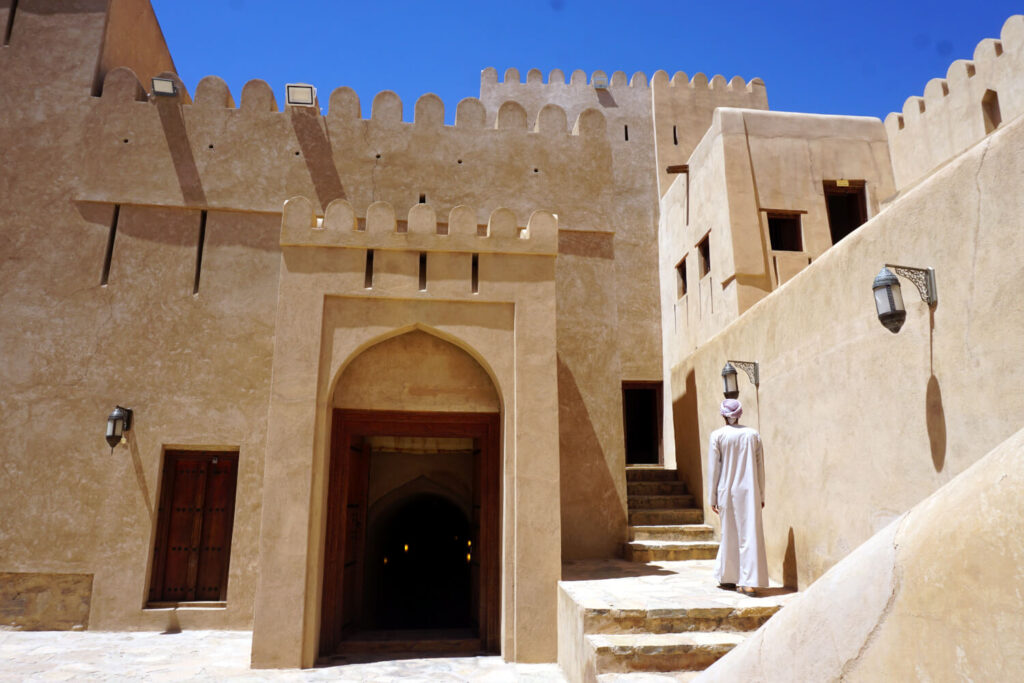
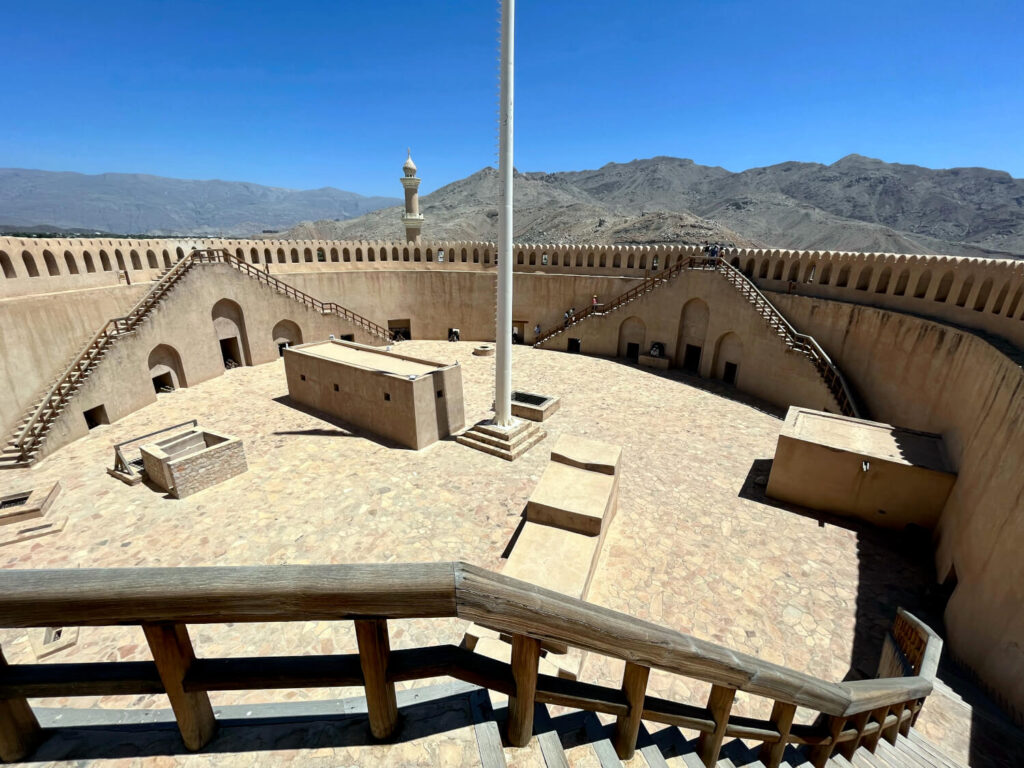
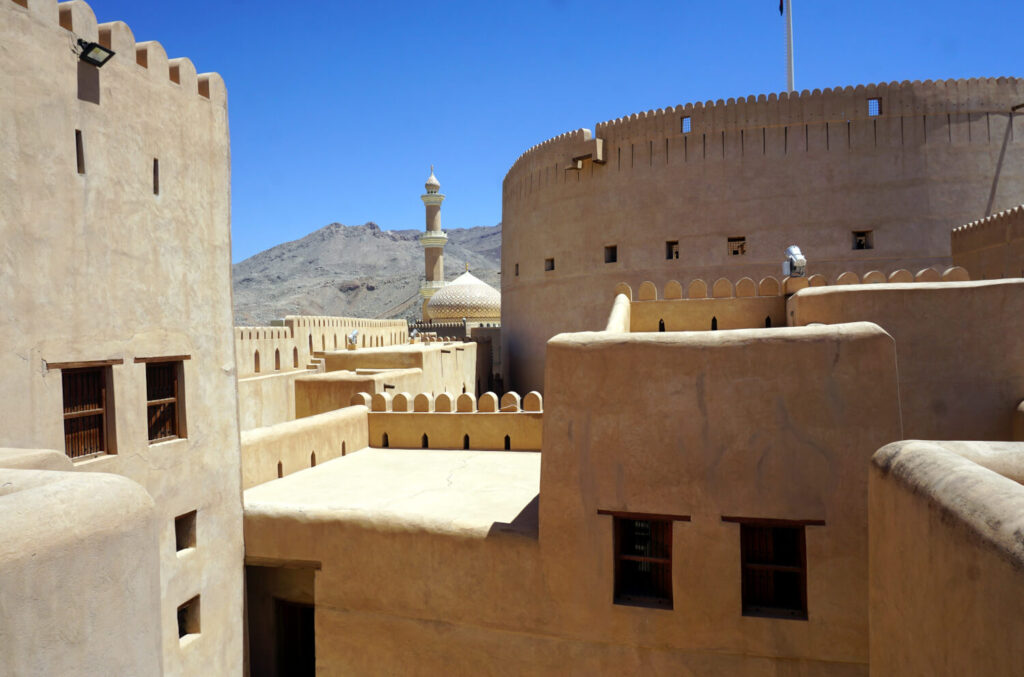
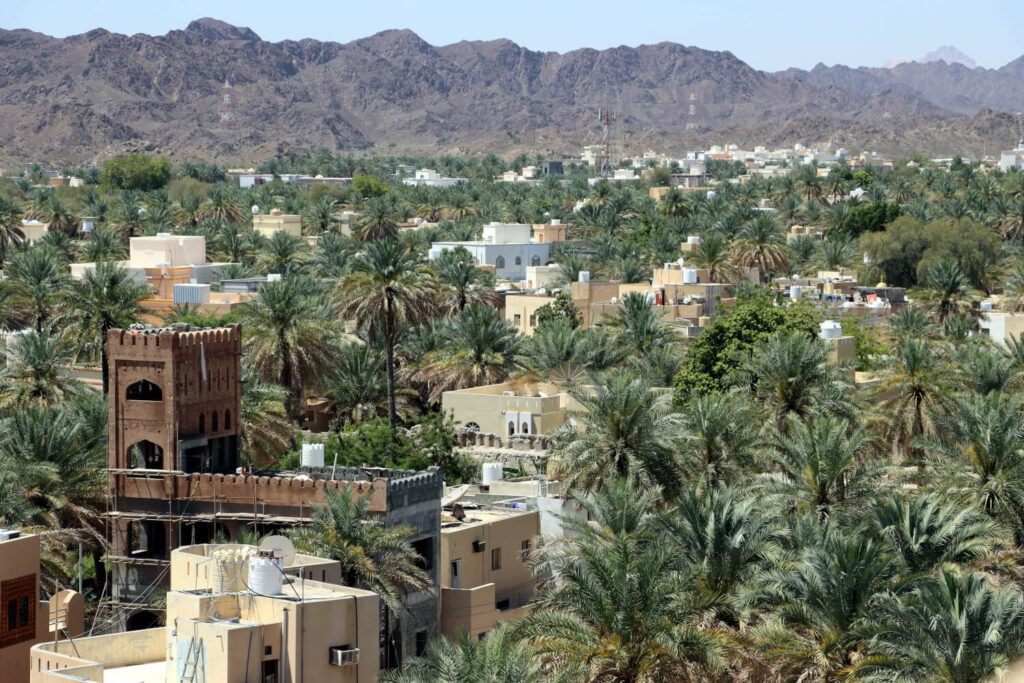
The Nizwa Fortress is one of the country’s most famous historical landmarks and an outstanding example of traditional Omani architecture and engineering. Its most striking element is the imposing round tower, which impresses with a diameter of around 45 meters and a height of 34 meters. Originally, this tower was used for both defense and surveillance and provided protection for the city and its inhabitants.
Travel with the soul: Oman’s unspoiled beauty
From its peak, visitors enjoy spectacular views of the surrounding mountains, lush palm groves and the former capital of Oman, Nizwa – a sight that perfectly captures the beauty and cultural significance of this place steeped in history.
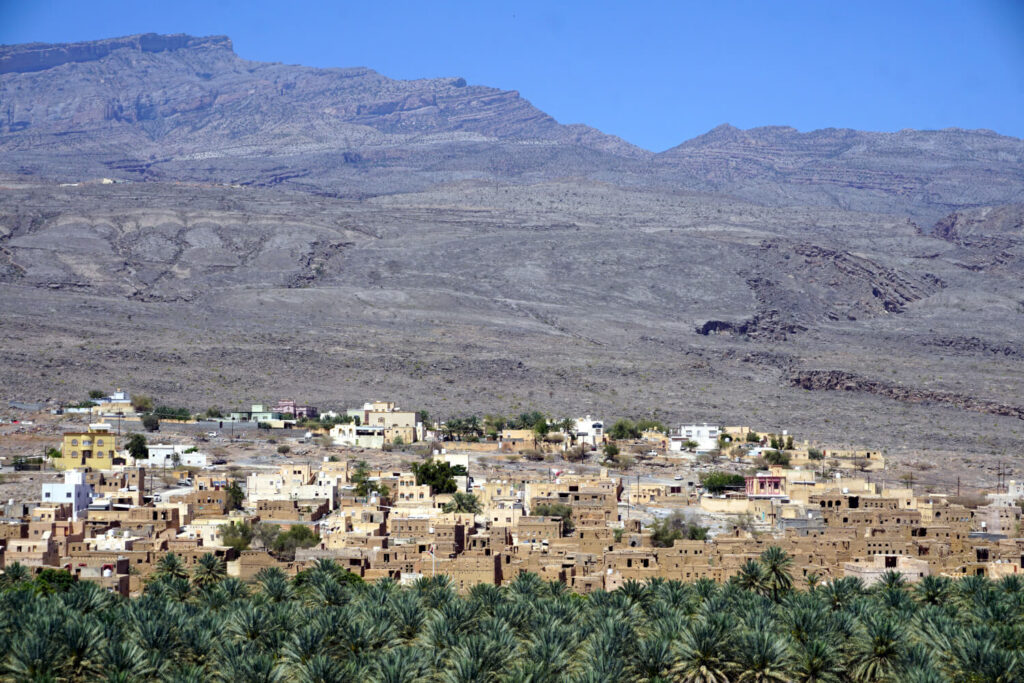
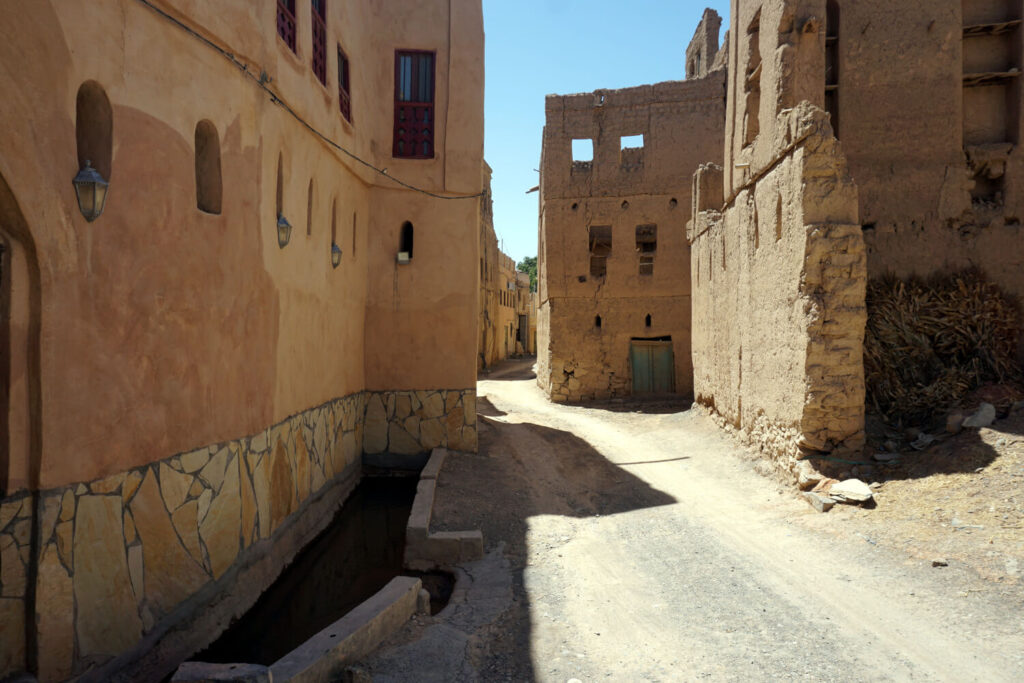
Our journey continued to Al Hamra, one of Oman’s oldest and most historic cities. This fascinating gem, located around 200 kilometers southwest of Muscat, impresses with its exceptionally well-preserved traditional mud architecture. Many of the impressive buildings are over 400 years old and were built in the traditional Omani style using mud bricks and palm wood – a living testimony to the craftsmanship of past centuries.
Hidden treasures in the Sultanate: the untouched beauty of Oman
First, we stopped at a viewpoint to enjoy an impressive panoramic view of the city and its surroundings. From here, the harmony between the historic buildings and the surrounding landscape is particularly evident. We then explored the narrow, winding alleyways of Al Hamra, which, with their rustic charm and authentic flair, offer a journey back in time.
Al Hamra is a place where the rich history and culture of Oman can be felt in every corner and is perfect for anyone looking for authentic experiences and unforgettable impressions.
Misfat al Abreyeen: A village in the middle of the mountains
Our next stop – an absolute highlight for photo enthusiasts – was the view of Misfat al Abreyeen from afar. This picturesque mountain village is one of the most beautiful and authentic in Oman and impresses with its unique clay architecture, which opens a window into the country’s past. The village nestles picturesquely on the slopes of the majestic Jebel Akhdar, also known as “The Green Mountain”. The white houses of the village form a fascinating contrast to the rugged rock formations and the lush vegetation, which is characterized by endless palm groves. A sight that perfectly captures the beauty of the Omani mountain landscape.
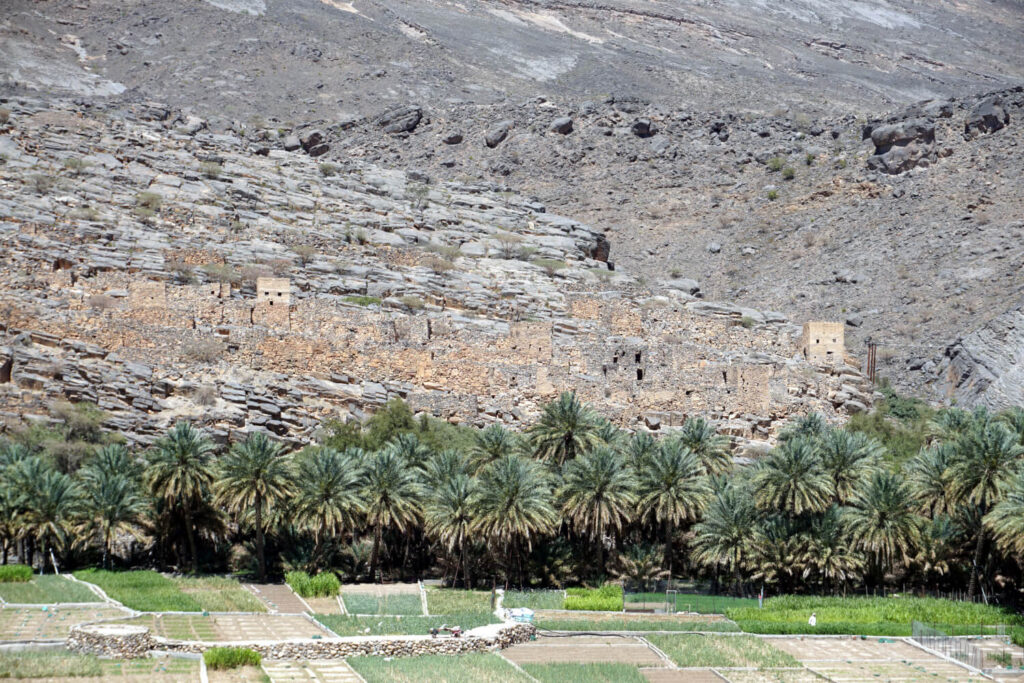
Our last stop of the day was literally the highlight of our trip: the majestic Jabal Shams, also known as Jebel Shams. This imposing peak is the highest mountain in Oman and part of the impressive Al-Hadjar mountain range. The name “Mountain of the Sun” has a poetic meaning, as this is where the first rays of sunshine greet Oman every morning. At a height of around 3,000 meters, Jabal Shams towers majestically over the landscape and captivates nature lovers and adventurers alike.
The magnificent view from Jebel Shams
The mountain is particularly famous for its spectacular view of the so-called “Grand Canyon of Oman” – the Wadi Ghul. This gigantic gorge, characterized by steep rock faces and deep gorges, is a true natural wonder and offered us an incomparable panoramic view that took our breath away.
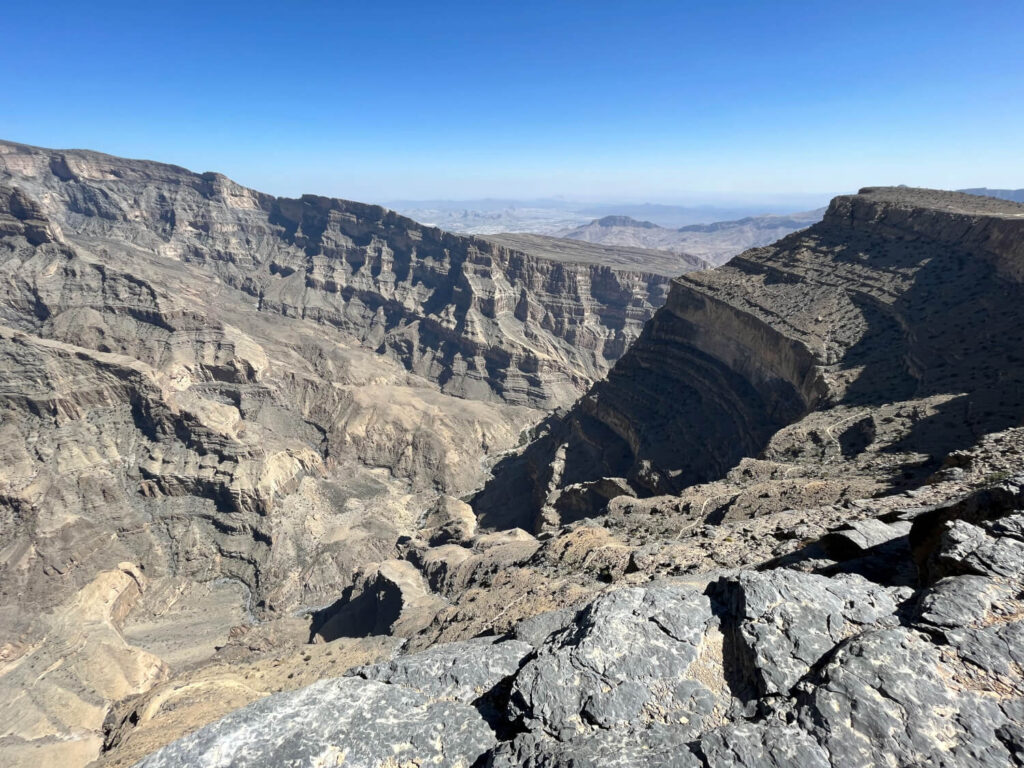
The tour came to a perfect end in this incomparable place, and we could hardly believe how many breathtaking impressions we were able to gather in one day. The Jabal Shams will undoubtedly remain in our memories as one of the greatest highlights of our trip.
Muscat – a different kind of city trip.
The third day of our trip to Oman was dedicated to exploring Muscat – the lively capital of the Sultanate. We had booked the “Half-Day Muscat Private City Tour” through Viator, a four-hour discovery tour through the city that was designed to show us the most important sights. It was the perfect opportunity to get to know Muscat even better before we continued our trip with a week of relaxation on the beach.
However, the tour, which was originally scheduled to take four hours, turned out to be a little tight. With eight planned stops, we ultimately only managed six – and that with an overrun of 30 minutes, which cost us an additional 10 Omani Rial (around 24 Euros). What we would normally have found annoying seemed surprisingly acceptable in Oman. We simply saw it as a contribution to quality assurance, especially as our driver and guide were always friendly, respectful and relaxed.
The hospitality of the Omanis: an unforgettable experience
Our stops included some of Muscat’s most important sights: the magnificent Sultan Qaboos Grand Mosque, the elegant Royal Opera House, the historic Bait Al Zubair Museum, the majestic Al Alam Palace, the impressive Mirani Fort and the lively Mutrah Souq. We skipped two stops: Qurum Beach, as we planned to have plenty of beach time in the coming days, and the National Museum, which was described as larger and more expensive, but thematically similar to the Bait Al Zubair.
Our first stop took us to the impressive Sultan Qaboos Grand Mosque – one of Oman’s most famous landmarks and an architectural masterpiece of global significance. Thanks to our guide, we didn’t have to pay an additional entrance fee and were able to immerse ourselves directly in this magnificent world. The mosque, which was built between 1995 and 2001, symbolizes the country’s cultural and religious identity and is one of the largest mosques in the world.
A paradise made of stones: The Sultan Qaboos Mosque
With a capacity for around 20,000 worshippers, including 6,500 in the main prayer hall, 8,000 in the outdoor areas and 750 in the women’s prayer hall, its sheer size is impressive. Particularly noteworthy: the Sultan Qaboos Grand Mosque is one of the few mosques in Oman that is also open to non-Muslims. Visits are usually possible in the mornings, although an appropriate dress code must be adhered to – covered shoulders and legs and a head covering for women are mandatory.
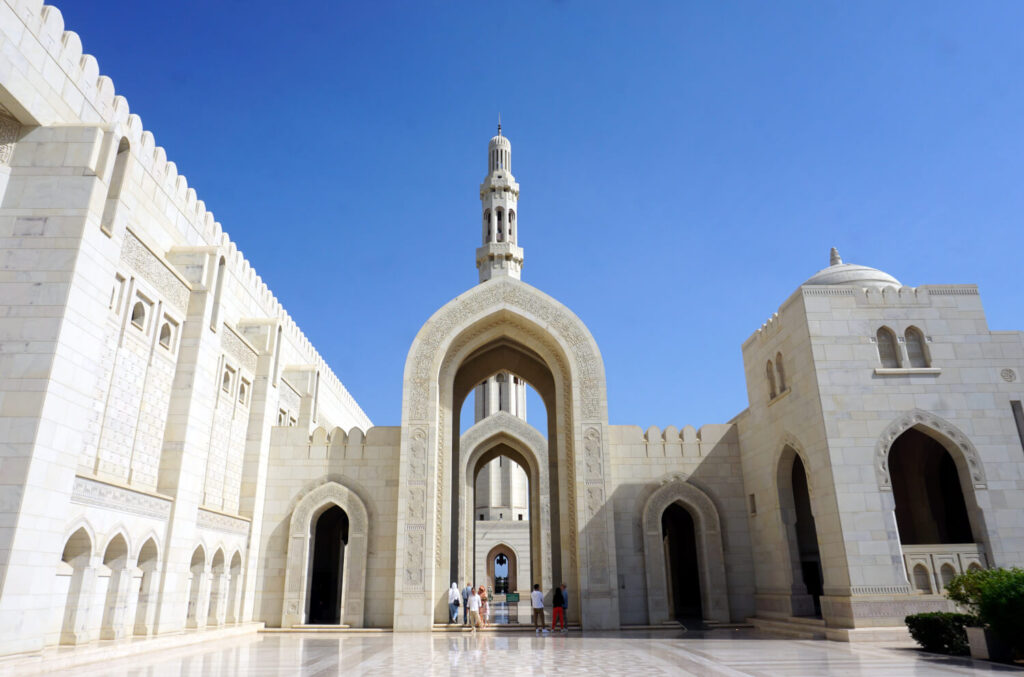
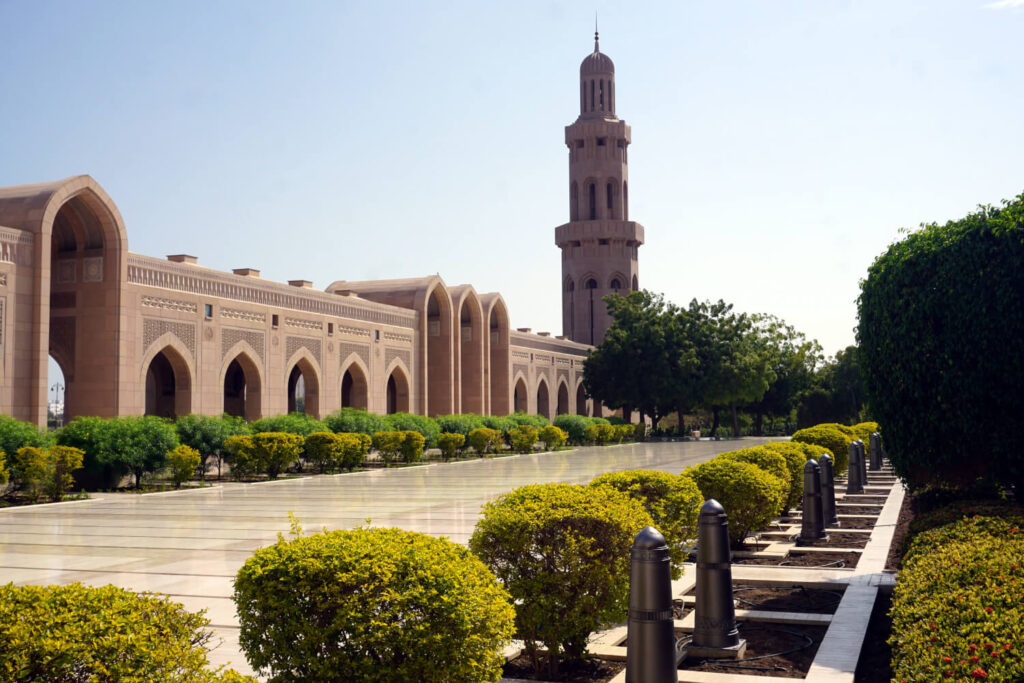
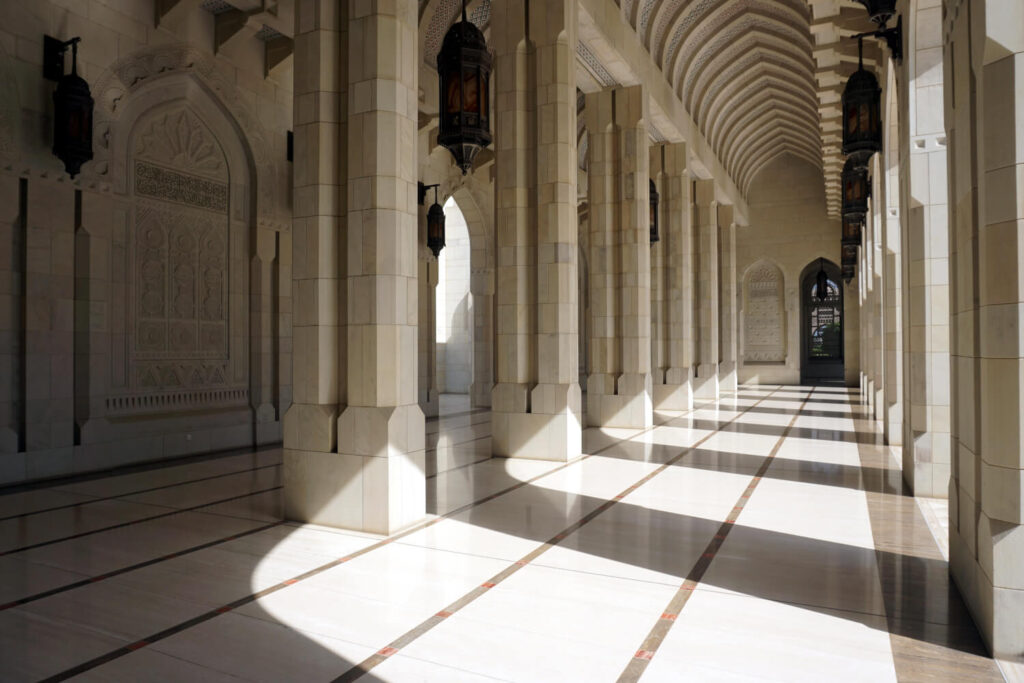
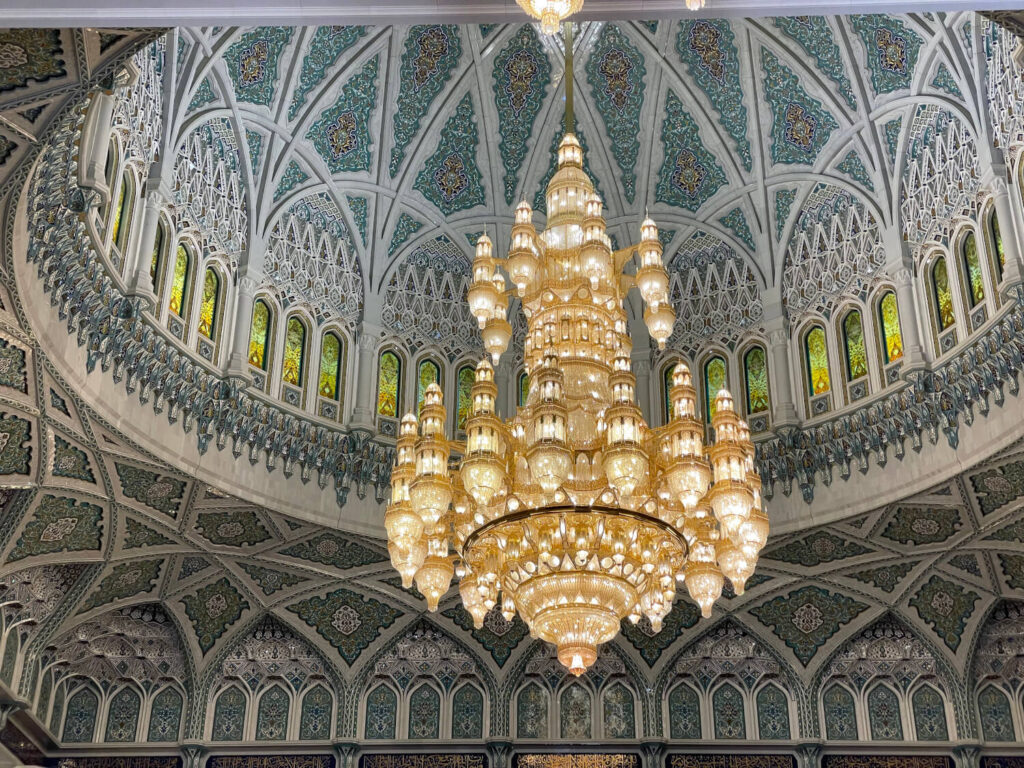
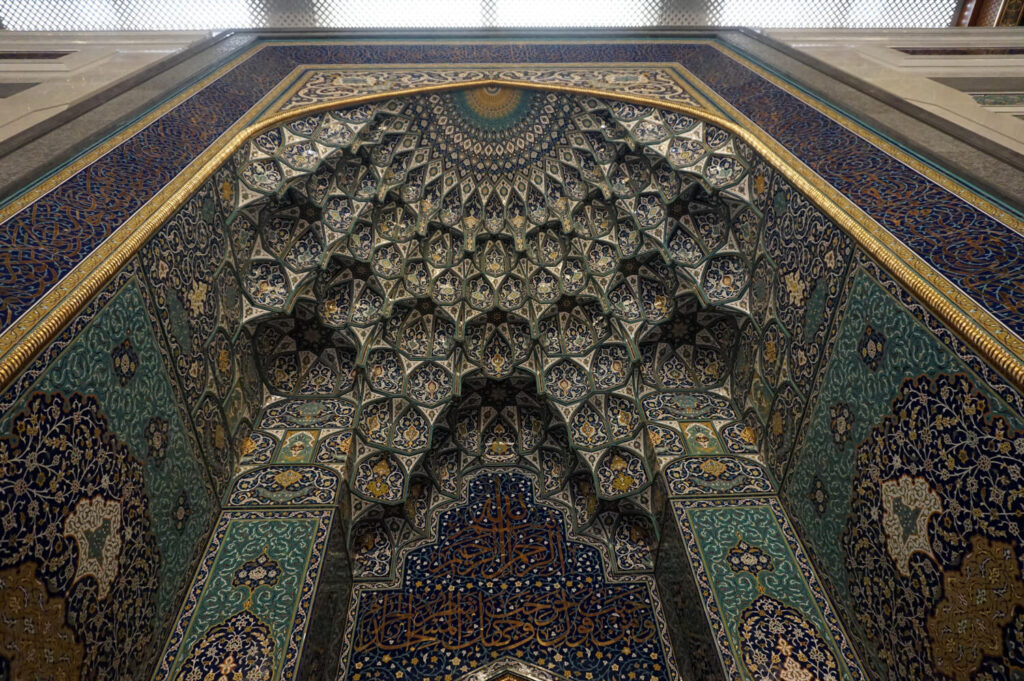
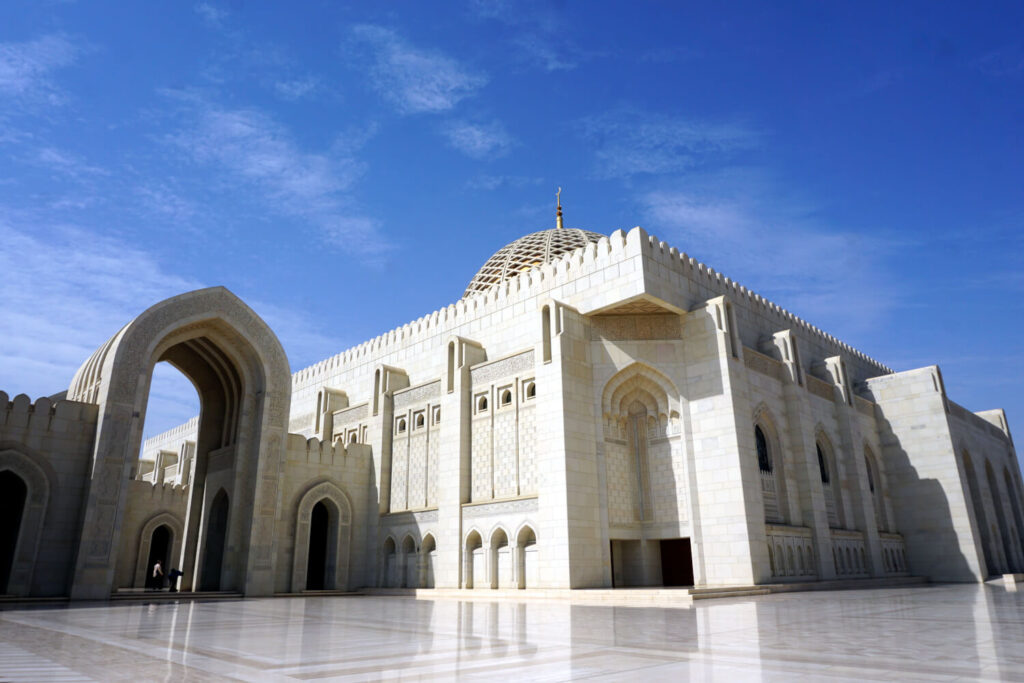
An absolute highlight awaits visitors in the main prayer hall: the magnificent, hand-knotted carpet, which with an area of around 4,300 square meters (for comparison: a soccer pitch has approx. 7,000 square meters) was considered the largest in the world until 2007 (weight: 20 cars or approx. 22 tons). It was handmade in Iran by over 600 women and gives the mosque a unique aura. The Sultan Qaboos Grand Mosque is undoubtedly a place of impressive beauty and spiritual significance that leaves a lasting impression on every visitor.
Theater and culture in Oman: The Royal Opera House
Our next stop was the Royal Opera House. After paying the entrance fee, we were introduced to the impressive world of this architectural masterpiece, which harmoniously combines different styles, as part of a guided tour.
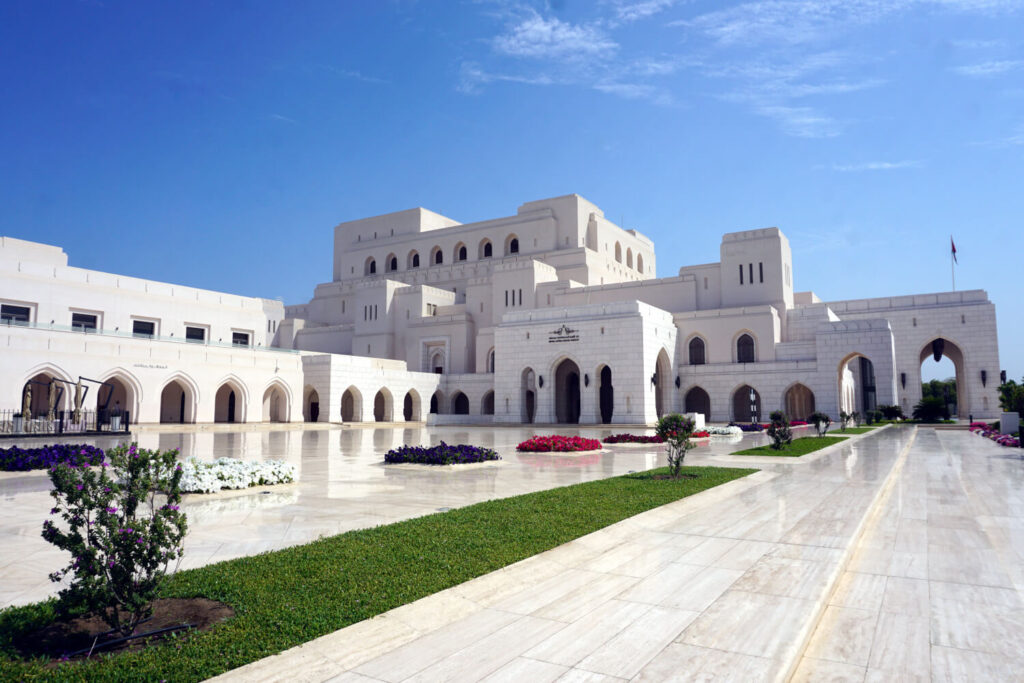
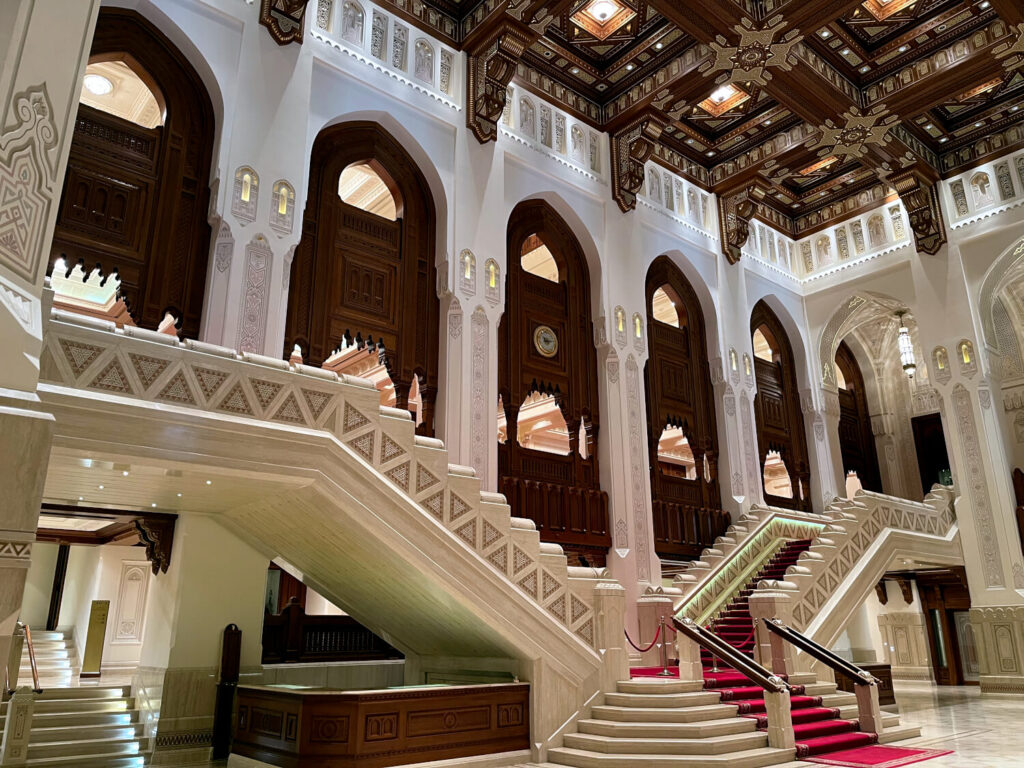
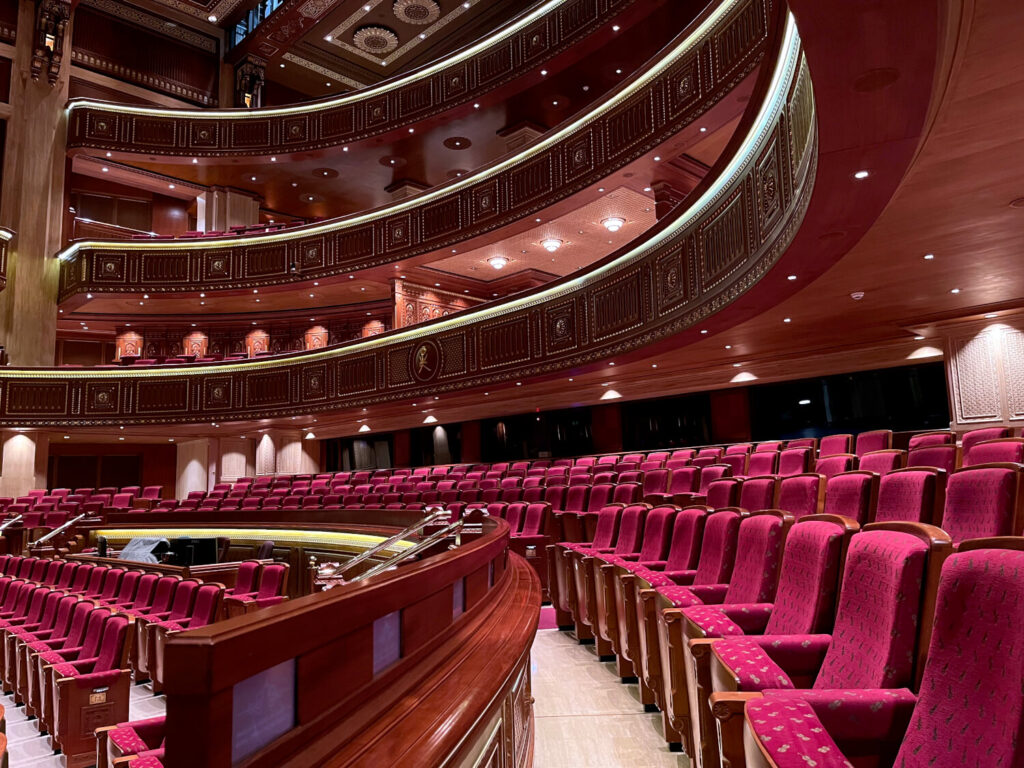
The Royal Opera House, opened in 2011 under the patronage of Sultan Qaboos bin Said, is considered the leading center for art and culture in Oman. It embodies the Sultanate’s appreciation of the performing arts and combines traditional Omani architecture with modern design elements. The magnificent building offers space for around 1,100 spectators and is equipped with state-of-the-art acoustic and stage technology that meets the highest international standards.
A journey into the unknown: Discover Oman
A special highlight of the opera house is the largest movable organ in the world, which weighs an impressive 500 tons. In addition to opera performances, concerts, ballet, plays and other cultural events from all over the world take place here. The Royal Opera House is therefore not only a cultural jewel of Oman, but also a symbol of the successful combination of tradition and modernity.
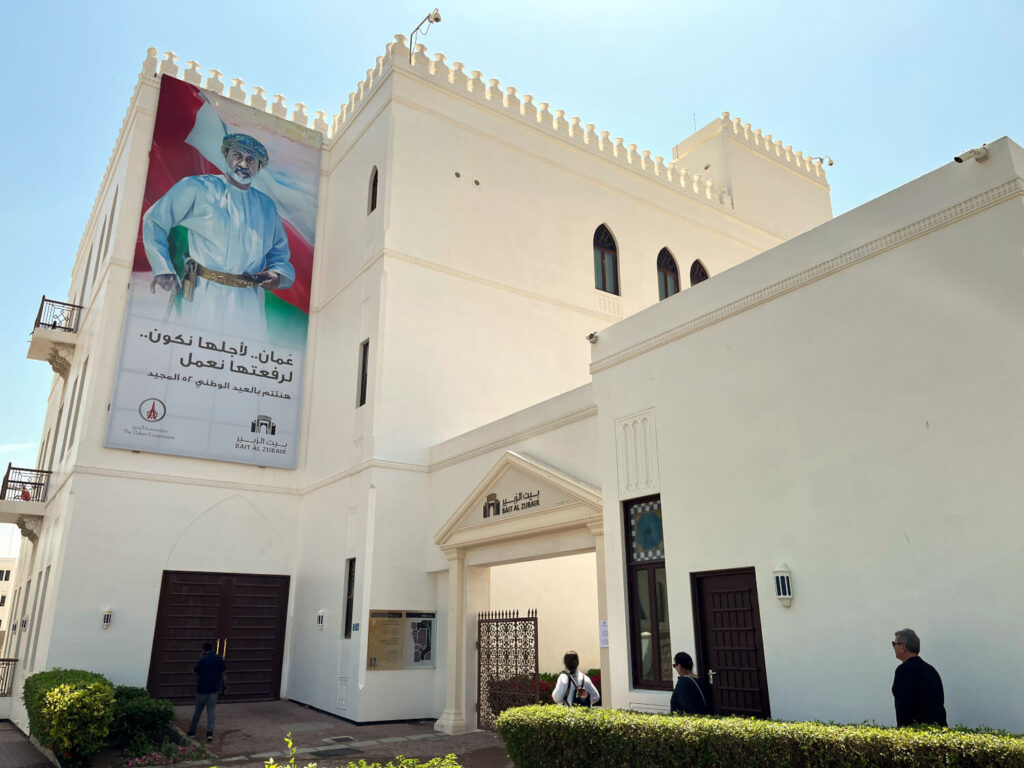
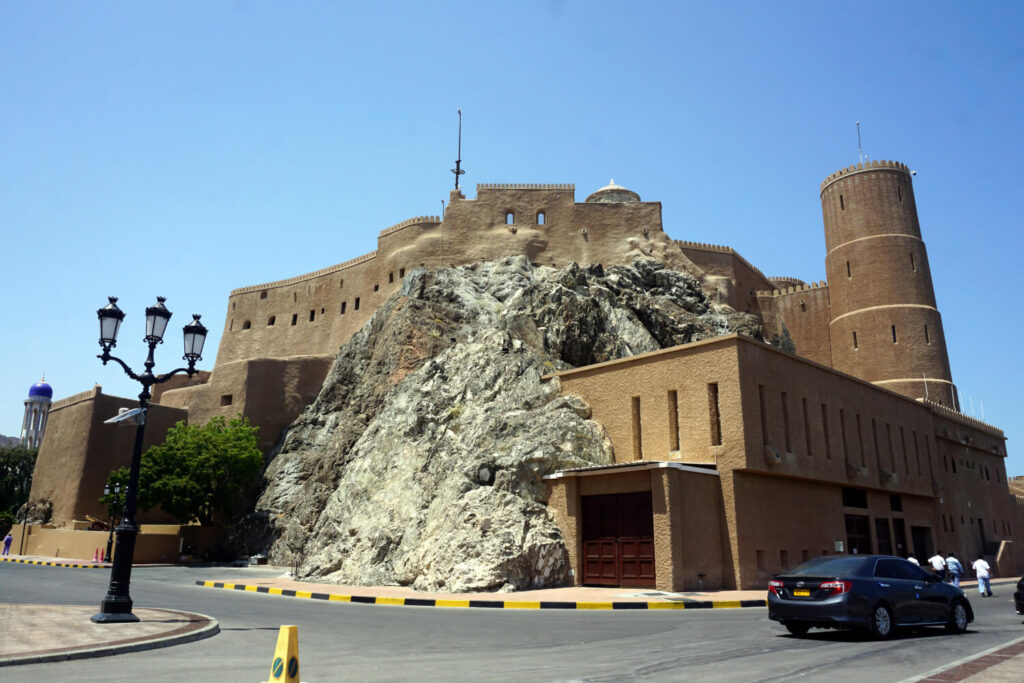
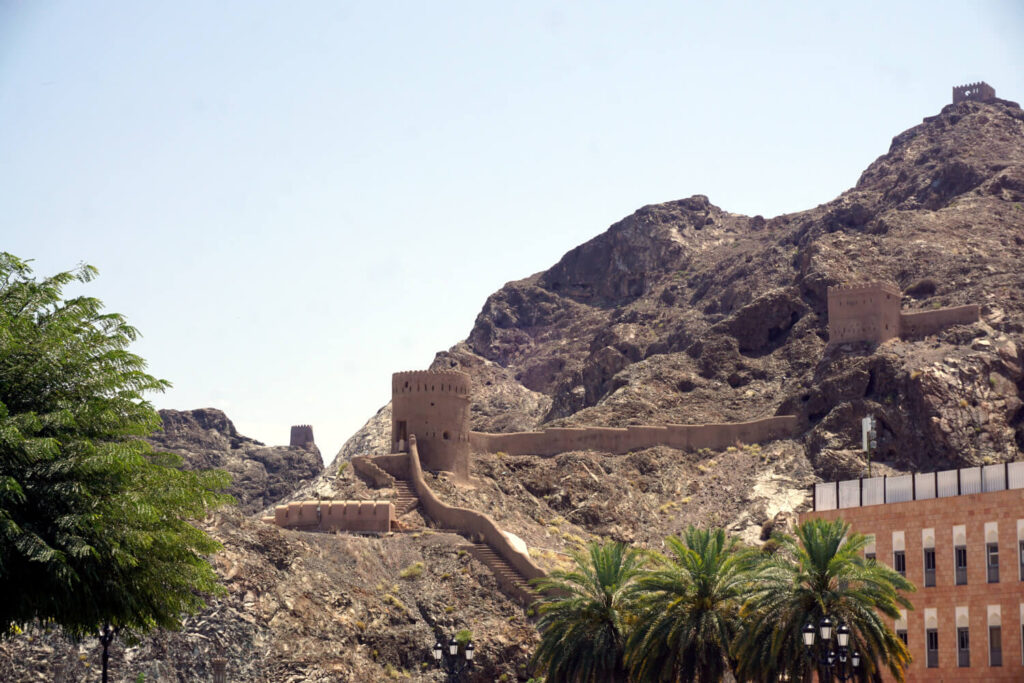
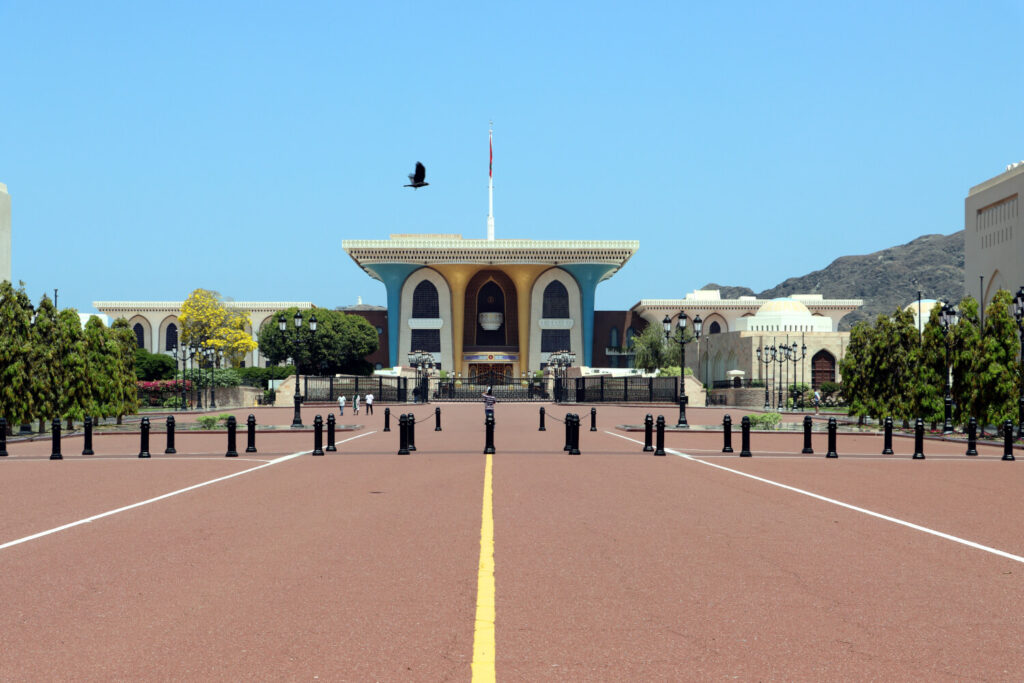
Our third stop on this eventful day was the Bait Al Zubair Museum, one of the most important museums in Oman. After paying the entrance fee, we had the opportunity to explore the museum at our own pace. Founded in 1998, the Bait Al Zubair is a cultural gem run by the Zubair Foundation – a private initiative dedicated to the preservation and promotion of Omani culture and history.
The Al Alam Palace: a royal masterpiece
Housed in a traditional building, the museum offers fascinating insights into the country’s rich history, art and traditions. Particularly impressive were the exhibitions of traditional clothing, jewelry and weapons, which impressively illustrate the rich cultural heritage of the Sultanate. Only the extensive collection of stamps and coins was a little overwhelming for us. Overall, however, the visit offered a varied and informative journey through the history of Oman, which we thoroughly enjoyed.
Our next stop took us to Al Alam Palace, a true masterpiece of Omani architecture. This magnificent palace, also known as the “Palace of the Flag”, is one of the most impressive royal residences in Oman. As one of the Sultan’s six residences, Al Alam Palace is not open to the public, but its majestic facade with striking blue and gold columns and beautifully landscaped gardens captivate many visitors. A truly fascinating example of modern architecture that reflects the cultural splendor of Oman and impresses both locals and tourists alike.
Protection from two sides: Mirani and Al Jalali Fort
Our penultimate stop took us to the imposing Mirani and Al Jalali forts, which are strategically perched on hills to the east and west of Al Alam Palace. This stop was purely a photo opportunity to admire the impressive buildings from the outside. The Mirani Fort was built in the 16th century by the Portuguese as they attempted to assert their colonial ambitions in the region. It played a decisive role in the defense of Muscat against various attackers. Today, the fort remains inaccessible, but its striking silhouette characterizes the cityscape and offers a fascinating view of the coast and the surrounding city from the outside.
The Al Jalali Fort, built somewhat later by the Portuguese, has also established itself as an unshakeable landmark of Omani history. It is particularly known for its impressive architecture and its strategic importance in guarding the port of Muscat. Like the Mirani Fort, Al Jalali is not open to the public, but this fortress also impressively symbolizes the history of the Portuguese presence in Oman.
The mystical atmosphere of Mutrah Souq
To round off our tour, we headed for the famous Mutrah Souq. However, before we immersed ourselves in the colorful hustle and bustle of the market, we took the opportunity to take a souvenir photo on the promenade opposite – an iconic image of Muscat that we could take home with us.
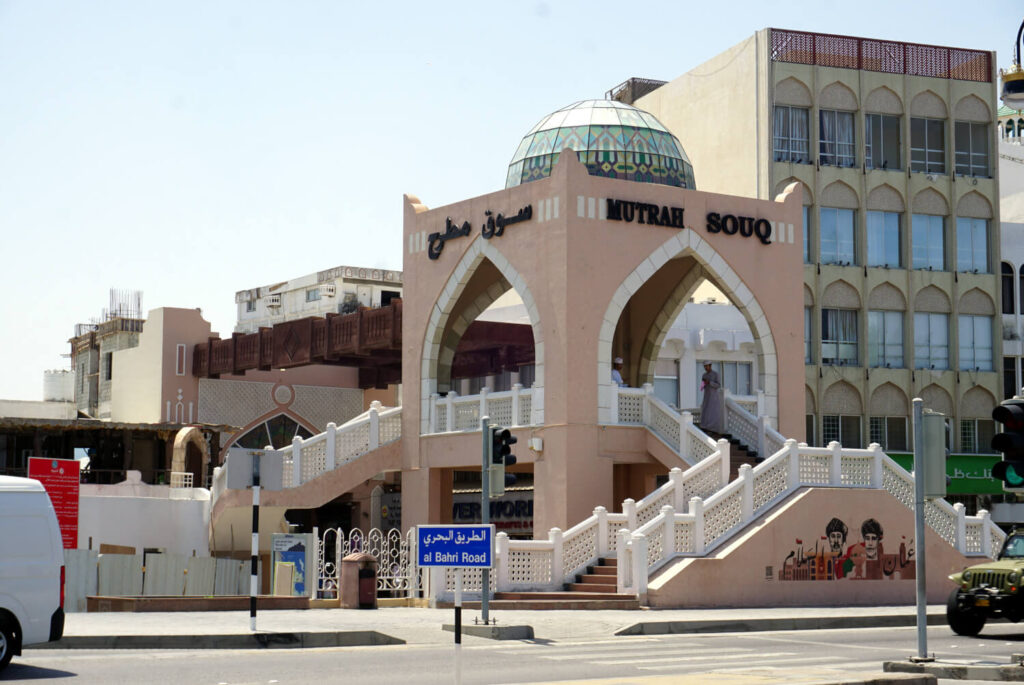
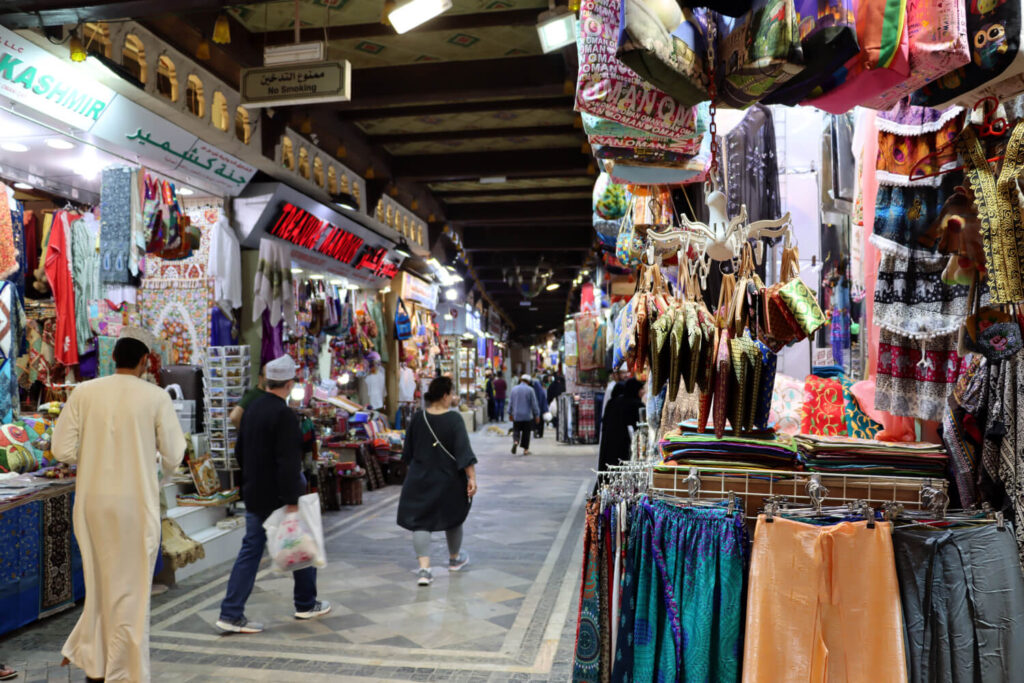
The Mutrah Souq is one of the oldest and most famous markets in Oman and offers a fascinating insight into Omani trading and cultural traditions. Its narrow, winding alleyways run through the heart of the souq and create an authentic atmosphere in which the history of trade comes to life. Surrounded by the captivating aromas of spices, the sound of coins and the hustle and bustle of traders, you feel as if you have been transported back in time.
A journey through the golden desert of Oman
The variety of products on offer is particularly appealing, ranging from traditional handicrafts to modern creations. This souq is a true paradise for lovers of handmade jewelry, art objects, spices, textiles, leather goods and traditional Omani clothing. The artfully crafted khanjar, the traditional Omani knife, and the exquisite gold and silversmithing are particularly striking and reflect the country’s heritage.
However, the Mutrah Souq is not just a place to shop – it is a vibrant cultural experience. Here, visitors can talk to the traders, learn more about the traditions of Oman and be mesmerized by the unique atmosphere of the market. Unlike many other markets, the atmosphere here is calm and respectful. We were lucky enough to try on traditional clothing and were gifted with a magically fragrant oil that I still apply drop by drop on special occasions. So if any of you are traveling to Muscat, take a small bottle of Saud al Hadi Trading with you – I swear it’s worth it!
Beach, relaxation, luxury and turtles
After the numerous impressions and unforgettable sights, it was finally time to relax and unwind. So after the last tour in the afternoon, we moved to the luxurious 5-star resort Shangri-La Barr Al Jissah, about 30 kilometers from Muscat. The resort, which looks like something straight out of a James Bond movie, is nestled right into the rocks and offers a breathtaking backdrop. It is home to several hotels, first-class restaurants, spacious pool areas (the “Lazy River” was an absolute highlight), exclusive beach areas, camel rides, sports facilities, a spacious spa and wellness area and much more.
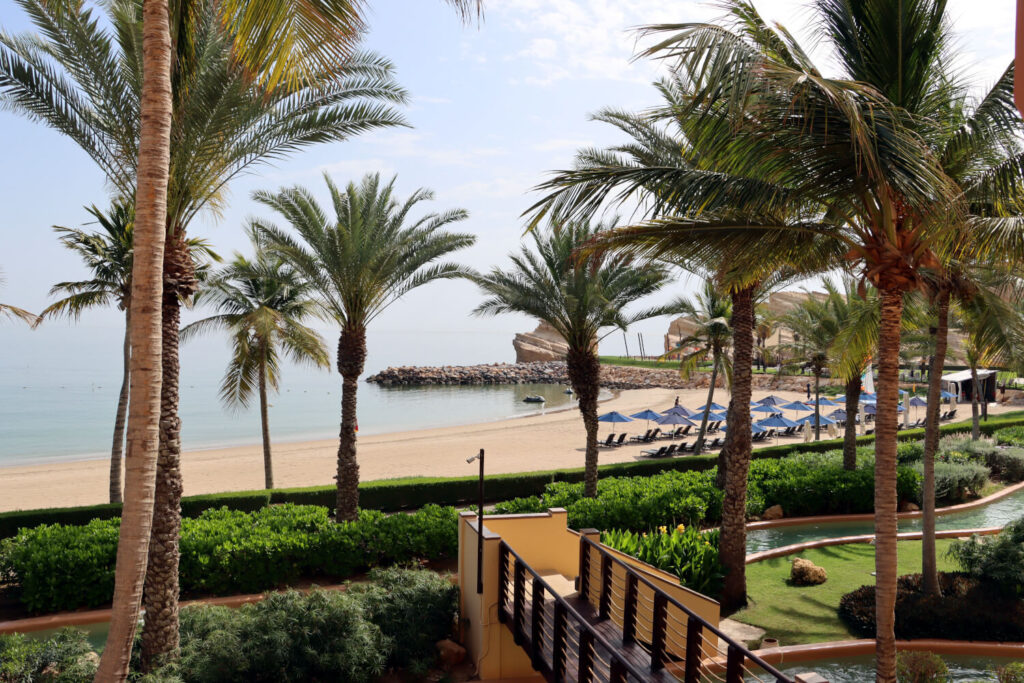
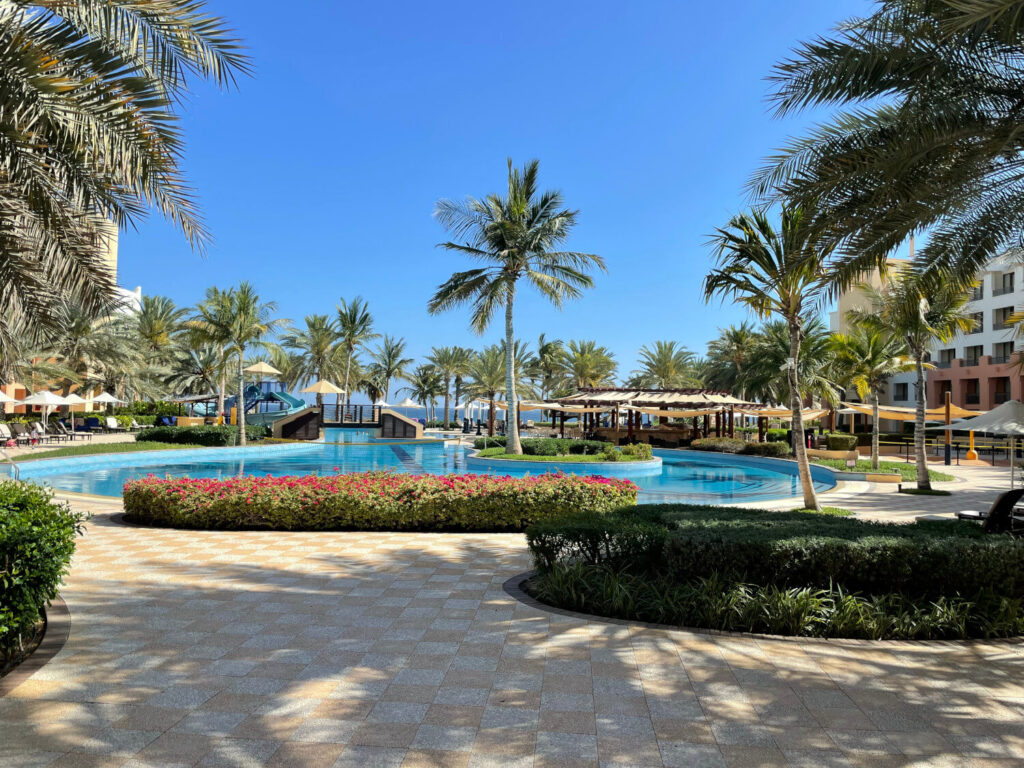
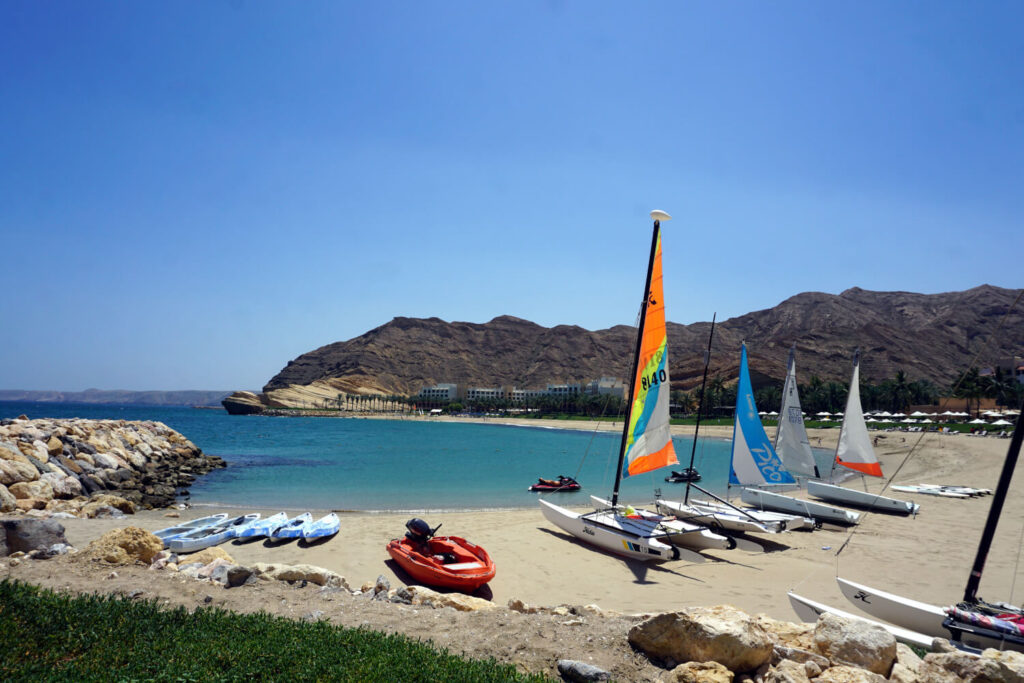
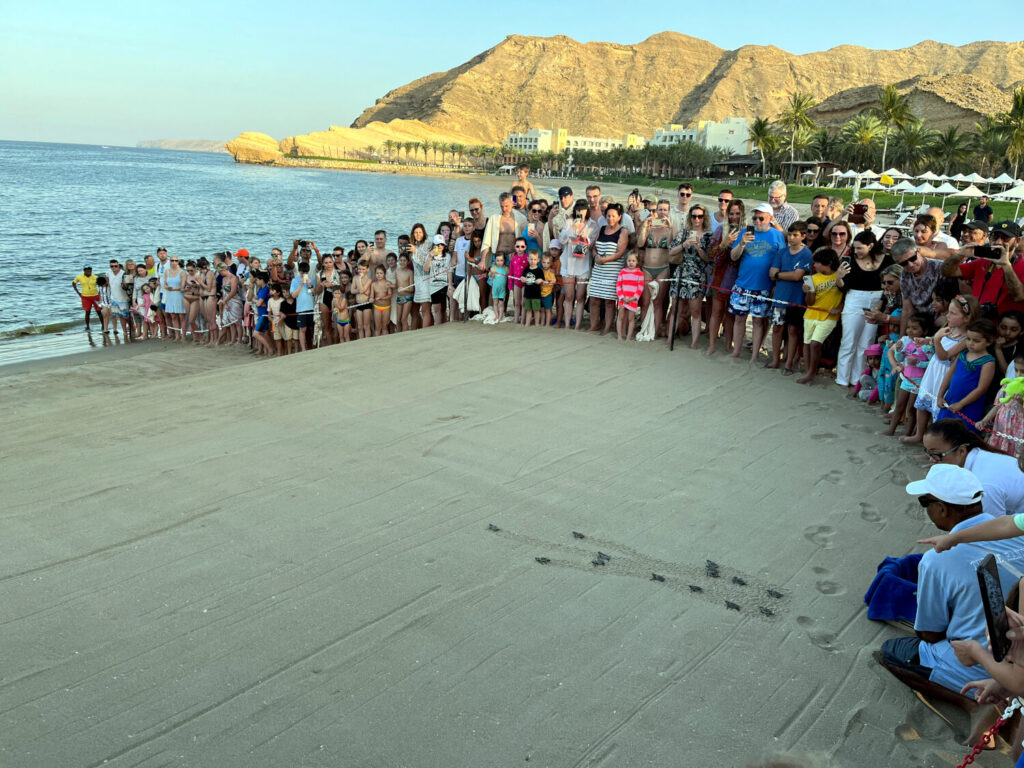
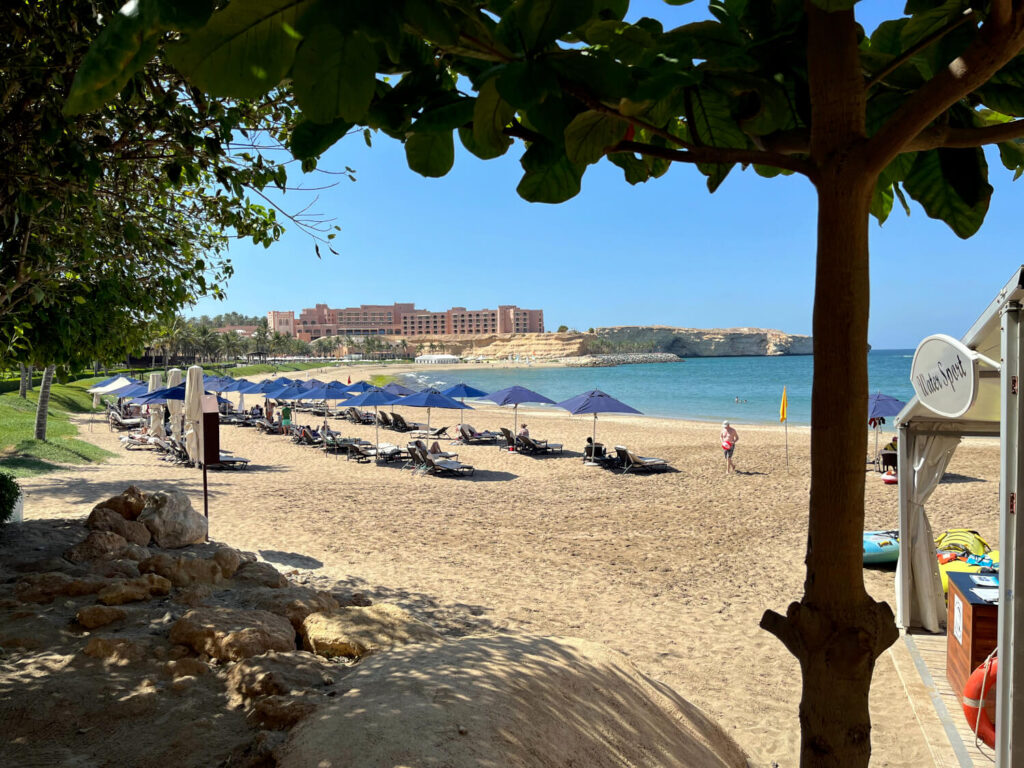
We were treated to a particularly fascinating nature experience on the day of our arrival with the hatching of baby turtles: there are nesting sites for sea turtles on selected beaches of the resort. We were alerted in time via the resort’s own app and were able to witness the magical moments of the turtles hatching and the burying of the eggs during our stay. It was an extraordinary natural spectacle that we felt was a real privilege.
The charm of Oman: where history and nature merge
We spent our days in a true paradise: On the private beach, perfectly supplied with towels and a cooling box with refreshing water, as well as in the pools, which invited us to relax. Pampered with culinary delights from the buffet, we were able to enjoy our time to the full. Even during Ramadan, our stay at the Shangri-La Barr Al Jissah was simply perfect. Oman presented itself to us as a hospitable, exciting and varied destination – a place we can highly recommend. It may not always be completely professional, but it is 100% authentic – and that’s what makes it so special.
Interested in the Arab world? Then read on here.
We felt very safe and very warmly welcomed. Of course, as on any trip, a certain amount of attention is required.
Absolutely. Not only adventurers will get their money’s worth, but beach holidaymakers will also find wonderful opportunities in Oman.
Oman is an absolute monarchy (sultanate).
*The links to Check24 and Getyourguide contained in this article are so-called affiliate links. With these links, tripination.com receives a commission for mediated purchases. This does not increase the price for the customer.
